Marc Tyler Nobleman's Blog, page 146
September 6, 2011
Super '70s and '80s: Sea World superheroes water ski show—the skiers, part 5 of 10
Introduction to series "Super '70s and '80s."
Introduction to subseries "Sea World superheroes show" (including list of interviewees).
Skiers, part 4 of 10.
SWSH = Sea World superheroes
THE MISTAKES
What mistakes or accidents happened during a show?
Andy Hansen: LOL, a lot of costume funnies. When a water skier fell, it would be "non-superherolike," so that would create some humor. Some announcers were better than others at covering errors. Jimmy Olsen was the announcer character. Tom Freeburn was one of the best at it. He was very animated and a good communicator.
Bill Peterson: Pyramid fall, star double falls, jump falls, barefoot falls. Accidents usually were knee injuries, but the most dangerous falls were when the top girl in the pyramid would fall into the ropes. Could possibly result in a serious injury if she were to become tangled in the ski ropes of the other skiers. It did happen, I think only once. But when it did everyone went down like a domino effect. So everything stopped until everyone got untangled and was seen to be okay. Falls in the kite could be fatal. Andy Hansen had an almost fatal fall in a kite once. I was hit in the head a few times by skiers accidentally running over me during a fall. No one was seriously injured when I was there, but the fear made us all extra-cautious.
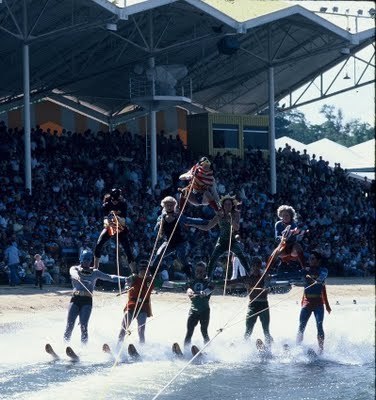 Note the flag.
Note the flag.
Bill Schwartz: If it was an acting error, we just continued. The audience wouldn't even notice. If one of the star water ski acts would fall, the announcer would ad-lib, explain the difficulty in the act, and the skier/skiers would re-perform the act.
Bubby Snow: Superman's wig falling off was the most common.
Carl Lipsit: Kite flying was probably the most dangerous (I didn't fly the kite). It was a relatively small lake and it was difficult to get the kite to the proper altitude. Kite would get locked in a climb position until power was dropped from the boat. Had to be monitored very closely. There were standard hazards such as hitting a ski that was left in the water, someone falling unintentionally to the front of a human pyramid, motor problems that caused slow starts/heavy strain when a pyramid group left the docks, ropes snapping when doing an "around the world," and, of course, just taking some good tumbles when barefooting or, in particular, in one scene where three people barefooting tried to wipe the others out and be the last man standing.
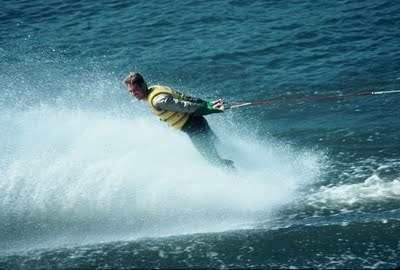 Diane Smith: Scenarios requiring not only acting but athletic abilities were even more unpredictable [than traditional live theater]. You have more variables in this type of show, including the weather, technical mishaps [with the boats, etc.], [and so on]. We all learned to camouflage the errors. We had a saying: "If the Flash fell" in the opening act, it was an omen and we should "be vigilant for subsequent falls." The most that usually happened was to begin a great show with audience attention and excitement, only to have that show held or cancelled due to lightning (and even an approaching tornado at one time).
Diane Smith: Scenarios requiring not only acting but athletic abilities were even more unpredictable [than traditional live theater]. You have more variables in this type of show, including the weather, technical mishaps [with the boats, etc.], [and so on]. We all learned to camouflage the errors. We had a saying: "If the Flash fell" in the opening act, it was an omen and we should "be vigilant for subsequent falls." The most that usually happened was to begin a great show with audience attention and excitement, only to have that show held or cancelled due to lightning (and even an approaching tornado at one time).
[During one] night show, the lights in the entire park suddenly went out. With no moonlight, we were in absolute darkness. There were other boats on the water. If a skier had fallen [into] the lake, the boat drivers would not be able to see that person and could hit the skier with the boat. Also, there were skis in the water which the pick-up boat had yet to retrieve from acts which dropped their skis mid-performance. If a skier then on the water were to hit a ski, it would probably knock that person into the water.
[When it went dark, the] ballet line was performing on the lake. We had just made our first pass, engaged in arm (with the ropes between our knees) and leg ballet movements. I was the first girl (of six or more) in the line, and thus had the responsibility to cut hard and strong enough so as to bring in all the girls and have a perfect beach landing. You wanted to land and enter the beach at the water's edge, just lightly enough to touch the sand, jump out of your ski, and then make a graceful bow to the audience. But I could not see the beach and I could not judge when to cut into the beach or how hard to pull and swerve to bring the line in uniformly. I used my best judgment, but the beach was closer than I thought. You see, even the boat driver with his bow light on could not see how close he should drive us as we circled to approach the stage. I pulled and we landed roughly, tumbling too far up in the sand to jump out of our skis, but fortunately, short of the solid barrier. No girl had fallen in the lake and we were all safe. Of course, the remainder of the show was cancelled and this situation was an anomaly. Never did a [show] event frighten me as much as that show in the eerie darkness.
Doby Buesse: A "no-fall show was common." A "no-fall day" was rare.
Jacque Cook (Kuntarich): One time I was doing an around-the-boat and you had a cape and cowl. I got clotheslined and my cape wrapped around the rope. Somehow in the fall a skier ran over my head. I kept saying "I can't see!" The pub (pickup) boat came. If somebody fell, you had to a pay a quarter into this petty cash thing. Then we went to buy drinks with it at the end of the month.
If there was a fall it was checked. You got paid according to how many acts you could do. You had to be consistent. There were days when we hadn't fallen in days and days.
One time Sharkey, this handsome boat driver, was waving at the crowd. We're in a pyramid and his elbow hit the ignition key and the boat stopped and we all collapsed dead center. In a pyramid, you don't want to jump because it's slightly angled backward. The boys are in front of you when you look down. (from a caption on Facebook: A safe pyramid fall was like a cartoon. It seemed like you hung in the air for a few seconds, then swish, down into the water.)
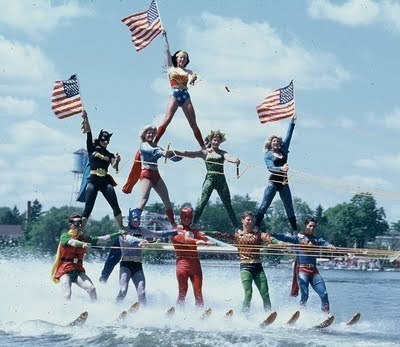 Once when we went to take off from the floating dock set, the boat cavitated. It pulled me off the dock. I tried to save [the move] but I somehow kicked myself in the face with my slalom ski and broke my right cheekbone. Back then they didn't have an ambulance waiting for us. Betsy drove me (still in the Batgirl costume) to the ER and kids said "Look, mommy, it's Batgirl." I had a concussion and the doctor said what's wrong and I kept saying "I'm Batgirl." Betsy hurt her ankle as Batgirl, too, and went to the hospital. While there, a doctor asked her if she'd go say hi to kids in another room.
Once when we went to take off from the floating dock set, the boat cavitated. It pulled me off the dock. I tried to save [the move] but I somehow kicked myself in the face with my slalom ski and broke my right cheekbone. Back then they didn't have an ambulance waiting for us. Betsy drove me (still in the Batgirl costume) to the ER and kids said "Look, mommy, it's Batgirl." I had a concussion and the doctor said what's wrong and I kept saying "I'm Batgirl." Betsy hurt her ankle as Batgirl, too, and went to the hospital. While there, a doctor asked her if she'd go say hi to kids in another room.
Janalee Zimmerman (Addleman): Towards the end of the season, I was practicing a lift with one of the guys and during that practice on land I dislocated his shoulder. :-( I can't remember his name, though.
Jeff Parnell: If you fell in an act, right after the show you went out and practiced until you did right several times. The guys started a fall fund—50 cents a fall and at the end of the summer we had a party.
Kaci Whittenton (Hedstrum): There were the obvious falls and some leading to broken bones, injured knees, and cuts. But the most memorable for me was Andy Hansen's kite-flying accident between shows. The kite collapsed and he fell (don't remember how many feet—it was a lot) into the water causing neck and head injury. They had to cut him loose from the submerged kite. Scary! I think there was a death that occurred during the boat opening act, but I was not working there at the time and I don't know the details.
Kerry Lloyd: Only people-error—people fall, not paying attention because they get complacent over time. They ski right into shore waving to girls.
Mark Gutleben: Bob Borth was the number one hotshot at the time, I thought. But the only thing he had over on me is they let him fly the kite. I guess the director was scared to let me do it—too wild. I had a boating accident here in 1980 and some guy hit me and put me in a coma. I feel a lot better than I did back then!
Nancy Radant Combes: One time I ruined a disappearing act for Black Canary. She was supposed to go into a kiosk and after the blinds were pulled down she would slip through a hole in the stage, change into a thug costume, and crawl out a tunnel. It had rained severely the night before and someone forgot to bilge out the tunnel. When I went to drop down, it was full of water and I refused to drop into the tunnel and "swim" out. So when the shades were opened, Black Canary was still there. I just screamed and ran off stage. My boss wasn't too happy.
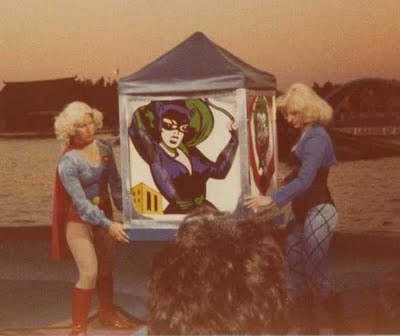 Paula Nelson (Bloemer): A stalled engine in front of a crowded stand can be a bit embarrassing. With the sometimes inhumane number of shows they scheduled, mistakes happened. The one I most clearly remember happened while I was playing Supergirl. In the show Supergirl and Superman take off on slalom skis and cut out hard in opposite directions, then the boat spins out doing a 360-degree turn . Now Superman and Supergirl are heading towards one another; Supergirl ducks down (which I did) and Superman lifts his rope up to avoid hitting Supergirl. However, one day one of the Supermen (I won't name names) had imbibed some sort of "kryptonite" cocktail and did not lift his rope up. Luckily, Supergirl was not beheaded in front of the audience! I had a nice welt across my cheek for awhile, but nothing permanent.
Paula Nelson (Bloemer): A stalled engine in front of a crowded stand can be a bit embarrassing. With the sometimes inhumane number of shows they scheduled, mistakes happened. The one I most clearly remember happened while I was playing Supergirl. In the show Supergirl and Superman take off on slalom skis and cut out hard in opposite directions, then the boat spins out doing a 360-degree turn . Now Superman and Supergirl are heading towards one another; Supergirl ducks down (which I did) and Superman lifts his rope up to avoid hitting Supergirl. However, one day one of the Supermen (I won't name names) had imbibed some sort of "kryptonite" cocktail and did not lift his rope up. Luckily, Supergirl was not beheaded in front of the audience! I had a nice welt across my cheek for awhile, but nothing permanent.
Randy Messer: Kite flying was the most dangerous. [Perhaps a] skier forgets to clip his harness into the kite and the kite takes off without him. This happened to Tom Weber in Ohio. The kite took off beautifully without him and then a couple hundred feet up it crashed onto the roof over the ski stadium filled with audience. Fortunately no one was hurt. There may even be footage of this.
[Perhaps the] kite goes up but the pull from boat is too much and something on the kite breaks. This happened to Andy Hansen. We were both getting in practice pulls. I'd just flown and was being ferried back to the takeoff area in the pick-up boat when Kerry Lloyd yelled that Andy had crashed. Andy's kite had folded up and he'd plummeted into the lake. He hit hard and the broken kite wrapped around him making it difficult to get to him. There is sail, cables, rope, harness material, floats on the kite all in the way of a rescue. He was pulled out of the water. The helmet he'd worn had bucketed and the strap nearly strangled him. There was a short time no one knew if he would survive. Everyone was very shook up. The driver was devastated; he'd driven kites before at Cypress Gardens and was competent. This all lead to Sea World restricting kite flying to Gary and eventually removing it from the show. Equipment and safety standards were not nearly what they were a few years later; it was still a fairly new sport in the late '70s.
Years later I nearly drowned after a kite broke on takeoff and left me in six-and-a-half foot water with a kite spread on top of me. Being only six feet tall, I could touch the bottom but not push up high enough to get air. I unclipped my harness and wriggled through cables until I could swim free.
Anyone could jump a boat; not a lot of skill required. We all loved jump boats; you could chime it and send up big walls of spray, soaking each other and even soaking the crowd, which we were constantly warned not to do. There were a few close calls—a few skiers were ejected from the boats. Somewhere there is a great video showing a skier thrown out and almost run over by another boat. The piece was being filmed for a promo for the Ohio park. Years later a jump boat went into the crowd in the Ohio park.
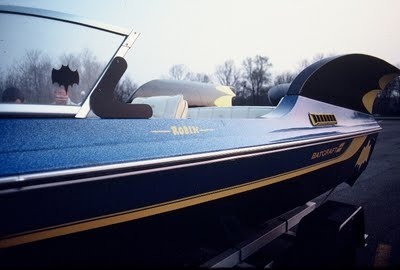 Jump act consisted of Superman, Green Lantern, Flash, and Aquaman. There were many crashes in jump acts and when we fell, the announcer often blamed it on villain treachery. It would be very embarrassing skiing into stage after a bad act.
Jump act consisted of Superman, Green Lantern, Flash, and Aquaman. There were many crashes in jump acts and when we fell, the announcer often blamed it on villain treachery. It would be very embarrassing skiing into stage after a bad act.
Harry Blackstone brought in the magic acts and we were all sworn to secrecy. Sawing a person in half, vanishing act, mixing body parts, and a cheese press with real spikes that really could kill someone if released improperly. It did spike Robin's cape one time and when it came time for him to pop up and say his lines, he was struggling to free himself.
The stage had trap doors with tunnel leading to back of the stage by the beach. Once in heavy rains the tunnel filled up and the female performer who dropped through the trap door found herself underwater and had to swim out thru the tunnel. There were some heroics along the way.
Sherry Wickstrom: Once Wonder Woman forgot to put on her magic rope. One practice of the pyramid on water we fell. The boat driver took the corner too tight. Some of the girls went forward, I went back. Someone said that as we went down, we looked like we were flying.
Shirley Duke: Sometimes the three-high pyramid would fall. After the conclusion of the show as the audience was leaving, we'd have to rebuild it; it was a highlight that the audience was looking forward to.
Next: skiers, part 6 of 10.

Introduction to subseries "Sea World superheroes show" (including list of interviewees).
Skiers, part 4 of 10.
SWSH = Sea World superheroes
THE MISTAKES
What mistakes or accidents happened during a show?
Andy Hansen: LOL, a lot of costume funnies. When a water skier fell, it would be "non-superherolike," so that would create some humor. Some announcers were better than others at covering errors. Jimmy Olsen was the announcer character. Tom Freeburn was one of the best at it. He was very animated and a good communicator.
Bill Peterson: Pyramid fall, star double falls, jump falls, barefoot falls. Accidents usually were knee injuries, but the most dangerous falls were when the top girl in the pyramid would fall into the ropes. Could possibly result in a serious injury if she were to become tangled in the ski ropes of the other skiers. It did happen, I think only once. But when it did everyone went down like a domino effect. So everything stopped until everyone got untangled and was seen to be okay. Falls in the kite could be fatal. Andy Hansen had an almost fatal fall in a kite once. I was hit in the head a few times by skiers accidentally running over me during a fall. No one was seriously injured when I was there, but the fear made us all extra-cautious.
 Note the flag.
Note the flag.Bill Schwartz: If it was an acting error, we just continued. The audience wouldn't even notice. If one of the star water ski acts would fall, the announcer would ad-lib, explain the difficulty in the act, and the skier/skiers would re-perform the act.
Bubby Snow: Superman's wig falling off was the most common.
Carl Lipsit: Kite flying was probably the most dangerous (I didn't fly the kite). It was a relatively small lake and it was difficult to get the kite to the proper altitude. Kite would get locked in a climb position until power was dropped from the boat. Had to be monitored very closely. There were standard hazards such as hitting a ski that was left in the water, someone falling unintentionally to the front of a human pyramid, motor problems that caused slow starts/heavy strain when a pyramid group left the docks, ropes snapping when doing an "around the world," and, of course, just taking some good tumbles when barefooting or, in particular, in one scene where three people barefooting tried to wipe the others out and be the last man standing.
 Diane Smith: Scenarios requiring not only acting but athletic abilities were even more unpredictable [than traditional live theater]. You have more variables in this type of show, including the weather, technical mishaps [with the boats, etc.], [and so on]. We all learned to camouflage the errors. We had a saying: "If the Flash fell" in the opening act, it was an omen and we should "be vigilant for subsequent falls." The most that usually happened was to begin a great show with audience attention and excitement, only to have that show held or cancelled due to lightning (and even an approaching tornado at one time).
Diane Smith: Scenarios requiring not only acting but athletic abilities were even more unpredictable [than traditional live theater]. You have more variables in this type of show, including the weather, technical mishaps [with the boats, etc.], [and so on]. We all learned to camouflage the errors. We had a saying: "If the Flash fell" in the opening act, it was an omen and we should "be vigilant for subsequent falls." The most that usually happened was to begin a great show with audience attention and excitement, only to have that show held or cancelled due to lightning (and even an approaching tornado at one time).[During one] night show, the lights in the entire park suddenly went out. With no moonlight, we were in absolute darkness. There were other boats on the water. If a skier had fallen [into] the lake, the boat drivers would not be able to see that person and could hit the skier with the boat. Also, there were skis in the water which the pick-up boat had yet to retrieve from acts which dropped their skis mid-performance. If a skier then on the water were to hit a ski, it would probably knock that person into the water.
[When it went dark, the] ballet line was performing on the lake. We had just made our first pass, engaged in arm (with the ropes between our knees) and leg ballet movements. I was the first girl (of six or more) in the line, and thus had the responsibility to cut hard and strong enough so as to bring in all the girls and have a perfect beach landing. You wanted to land and enter the beach at the water's edge, just lightly enough to touch the sand, jump out of your ski, and then make a graceful bow to the audience. But I could not see the beach and I could not judge when to cut into the beach or how hard to pull and swerve to bring the line in uniformly. I used my best judgment, but the beach was closer than I thought. You see, even the boat driver with his bow light on could not see how close he should drive us as we circled to approach the stage. I pulled and we landed roughly, tumbling too far up in the sand to jump out of our skis, but fortunately, short of the solid barrier. No girl had fallen in the lake and we were all safe. Of course, the remainder of the show was cancelled and this situation was an anomaly. Never did a [show] event frighten me as much as that show in the eerie darkness.
Doby Buesse: A "no-fall show was common." A "no-fall day" was rare.
Jacque Cook (Kuntarich): One time I was doing an around-the-boat and you had a cape and cowl. I got clotheslined and my cape wrapped around the rope. Somehow in the fall a skier ran over my head. I kept saying "I can't see!" The pub (pickup) boat came. If somebody fell, you had to a pay a quarter into this petty cash thing. Then we went to buy drinks with it at the end of the month.
If there was a fall it was checked. You got paid according to how many acts you could do. You had to be consistent. There were days when we hadn't fallen in days and days.
One time Sharkey, this handsome boat driver, was waving at the crowd. We're in a pyramid and his elbow hit the ignition key and the boat stopped and we all collapsed dead center. In a pyramid, you don't want to jump because it's slightly angled backward. The boys are in front of you when you look down. (from a caption on Facebook: A safe pyramid fall was like a cartoon. It seemed like you hung in the air for a few seconds, then swish, down into the water.)
 Once when we went to take off from the floating dock set, the boat cavitated. It pulled me off the dock. I tried to save [the move] but I somehow kicked myself in the face with my slalom ski and broke my right cheekbone. Back then they didn't have an ambulance waiting for us. Betsy drove me (still in the Batgirl costume) to the ER and kids said "Look, mommy, it's Batgirl." I had a concussion and the doctor said what's wrong and I kept saying "I'm Batgirl." Betsy hurt her ankle as Batgirl, too, and went to the hospital. While there, a doctor asked her if she'd go say hi to kids in another room.
Once when we went to take off from the floating dock set, the boat cavitated. It pulled me off the dock. I tried to save [the move] but I somehow kicked myself in the face with my slalom ski and broke my right cheekbone. Back then they didn't have an ambulance waiting for us. Betsy drove me (still in the Batgirl costume) to the ER and kids said "Look, mommy, it's Batgirl." I had a concussion and the doctor said what's wrong and I kept saying "I'm Batgirl." Betsy hurt her ankle as Batgirl, too, and went to the hospital. While there, a doctor asked her if she'd go say hi to kids in another room.Janalee Zimmerman (Addleman): Towards the end of the season, I was practicing a lift with one of the guys and during that practice on land I dislocated his shoulder. :-( I can't remember his name, though.
Jeff Parnell: If you fell in an act, right after the show you went out and practiced until you did right several times. The guys started a fall fund—50 cents a fall and at the end of the summer we had a party.
Kaci Whittenton (Hedstrum): There were the obvious falls and some leading to broken bones, injured knees, and cuts. But the most memorable for me was Andy Hansen's kite-flying accident between shows. The kite collapsed and he fell (don't remember how many feet—it was a lot) into the water causing neck and head injury. They had to cut him loose from the submerged kite. Scary! I think there was a death that occurred during the boat opening act, but I was not working there at the time and I don't know the details.
Kerry Lloyd: Only people-error—people fall, not paying attention because they get complacent over time. They ski right into shore waving to girls.
Mark Gutleben: Bob Borth was the number one hotshot at the time, I thought. But the only thing he had over on me is they let him fly the kite. I guess the director was scared to let me do it—too wild. I had a boating accident here in 1980 and some guy hit me and put me in a coma. I feel a lot better than I did back then!
Nancy Radant Combes: One time I ruined a disappearing act for Black Canary. She was supposed to go into a kiosk and after the blinds were pulled down she would slip through a hole in the stage, change into a thug costume, and crawl out a tunnel. It had rained severely the night before and someone forgot to bilge out the tunnel. When I went to drop down, it was full of water and I refused to drop into the tunnel and "swim" out. So when the shades were opened, Black Canary was still there. I just screamed and ran off stage. My boss wasn't too happy.
 Paula Nelson (Bloemer): A stalled engine in front of a crowded stand can be a bit embarrassing. With the sometimes inhumane number of shows they scheduled, mistakes happened. The one I most clearly remember happened while I was playing Supergirl. In the show Supergirl and Superman take off on slalom skis and cut out hard in opposite directions, then the boat spins out doing a 360-degree turn . Now Superman and Supergirl are heading towards one another; Supergirl ducks down (which I did) and Superman lifts his rope up to avoid hitting Supergirl. However, one day one of the Supermen (I won't name names) had imbibed some sort of "kryptonite" cocktail and did not lift his rope up. Luckily, Supergirl was not beheaded in front of the audience! I had a nice welt across my cheek for awhile, but nothing permanent.
Paula Nelson (Bloemer): A stalled engine in front of a crowded stand can be a bit embarrassing. With the sometimes inhumane number of shows they scheduled, mistakes happened. The one I most clearly remember happened while I was playing Supergirl. In the show Supergirl and Superman take off on slalom skis and cut out hard in opposite directions, then the boat spins out doing a 360-degree turn . Now Superman and Supergirl are heading towards one another; Supergirl ducks down (which I did) and Superman lifts his rope up to avoid hitting Supergirl. However, one day one of the Supermen (I won't name names) had imbibed some sort of "kryptonite" cocktail and did not lift his rope up. Luckily, Supergirl was not beheaded in front of the audience! I had a nice welt across my cheek for awhile, but nothing permanent.Randy Messer: Kite flying was the most dangerous. [Perhaps a] skier forgets to clip his harness into the kite and the kite takes off without him. This happened to Tom Weber in Ohio. The kite took off beautifully without him and then a couple hundred feet up it crashed onto the roof over the ski stadium filled with audience. Fortunately no one was hurt. There may even be footage of this.
[Perhaps the] kite goes up but the pull from boat is too much and something on the kite breaks. This happened to Andy Hansen. We were both getting in practice pulls. I'd just flown and was being ferried back to the takeoff area in the pick-up boat when Kerry Lloyd yelled that Andy had crashed. Andy's kite had folded up and he'd plummeted into the lake. He hit hard and the broken kite wrapped around him making it difficult to get to him. There is sail, cables, rope, harness material, floats on the kite all in the way of a rescue. He was pulled out of the water. The helmet he'd worn had bucketed and the strap nearly strangled him. There was a short time no one knew if he would survive. Everyone was very shook up. The driver was devastated; he'd driven kites before at Cypress Gardens and was competent. This all lead to Sea World restricting kite flying to Gary and eventually removing it from the show. Equipment and safety standards were not nearly what they were a few years later; it was still a fairly new sport in the late '70s.
Years later I nearly drowned after a kite broke on takeoff and left me in six-and-a-half foot water with a kite spread on top of me. Being only six feet tall, I could touch the bottom but not push up high enough to get air. I unclipped my harness and wriggled through cables until I could swim free.
Anyone could jump a boat; not a lot of skill required. We all loved jump boats; you could chime it and send up big walls of spray, soaking each other and even soaking the crowd, which we were constantly warned not to do. There were a few close calls—a few skiers were ejected from the boats. Somewhere there is a great video showing a skier thrown out and almost run over by another boat. The piece was being filmed for a promo for the Ohio park. Years later a jump boat went into the crowd in the Ohio park.
 Jump act consisted of Superman, Green Lantern, Flash, and Aquaman. There were many crashes in jump acts and when we fell, the announcer often blamed it on villain treachery. It would be very embarrassing skiing into stage after a bad act.
Jump act consisted of Superman, Green Lantern, Flash, and Aquaman. There were many crashes in jump acts and when we fell, the announcer often blamed it on villain treachery. It would be very embarrassing skiing into stage after a bad act.Harry Blackstone brought in the magic acts and we were all sworn to secrecy. Sawing a person in half, vanishing act, mixing body parts, and a cheese press with real spikes that really could kill someone if released improperly. It did spike Robin's cape one time and when it came time for him to pop up and say his lines, he was struggling to free himself.
The stage had trap doors with tunnel leading to back of the stage by the beach. Once in heavy rains the tunnel filled up and the female performer who dropped through the trap door found herself underwater and had to swim out thru the tunnel. There were some heroics along the way.
Sherry Wickstrom: Once Wonder Woman forgot to put on her magic rope. One practice of the pyramid on water we fell. The boat driver took the corner too tight. Some of the girls went forward, I went back. Someone said that as we went down, we looked like we were flying.
Shirley Duke: Sometimes the three-high pyramid would fall. After the conclusion of the show as the audience was leaving, we'd have to rebuild it; it was a highlight that the audience was looking forward to.
Next: skiers, part 6 of 10.
Published on September 06, 2011 04:38
September 5, 2011
Super '70s and '80s: Sea World superheroes water ski show—the skiers, part 4 of 10
Introduction to series "Super '70s and '80s."
Introduction to subseries "Sea World superheroes show" (including list of interviewees).
Skiers, part 3 of 10.
SWSH = Sea World superheroes
THE SHOW
What was the show's story?
Diane Smith: The story was what you would expect when superheroes and super villains interact. It was the classic good vs. evil scenario. The 45-minute shows were complex, however. So much was happening that one could not watch it all at the same time. There was Jimmy Olsen, the announcer, who described what was taking place on the water as he controlled the action. There were flivers (small boats) and boat drivers waving and circling on the water. "Magic" occurred on the stage with Catwoman and her whip and thugs dressed in black. On the beach, lifts and gymnastic bows were athletically yet delicately completed. There was great excitement on the water as boats approached from all directions and intricate skiing: jumping, doubles, trios, slaloming, shoe skiing, trick skiing, barefoot skiing, and more continued.
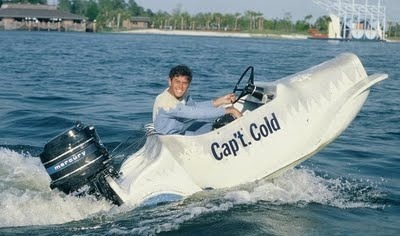 In the air, a kite flier soared as Gary Thompson signaled with his feet to the boat driver and then he made a perfect landing in front of the stands. Boats raced at each other with "near misses." On the diving platform, Tom Kaser climbed higher and higher until he seemed miles up and was finally perched at the top for his high dive into the lake which was flaming with fire. At first, he would not surface and the audience would gasp; then he would appear, smiling and ready to dive again in the next show. Characters would run down the steps in the stands, close enough for the audience to touch them. Some would pretend to be members of the audience and would run onto the set, jump into the water and ski or barefoot. It was genius. In our final stage bow, we signed off as our costumes dictated; only the boat drivers were introduced by their actual names. We even had gorgeous night shows…I remember just about turning purple from the chilling winds in the late December evening shows because we girls did not wear wetsuits, only our regular costumes. To this day, I don't believe there has ever been another [show] to equal it.
In the air, a kite flier soared as Gary Thompson signaled with his feet to the boat driver and then he made a perfect landing in front of the stands. Boats raced at each other with "near misses." On the diving platform, Tom Kaser climbed higher and higher until he seemed miles up and was finally perched at the top for his high dive into the lake which was flaming with fire. At first, he would not surface and the audience would gasp; then he would appear, smiling and ready to dive again in the next show. Characters would run down the steps in the stands, close enough for the audience to touch them. Some would pretend to be members of the audience and would run onto the set, jump into the water and ski or barefoot. It was genius. In our final stage bow, we signed off as our costumes dictated; only the boat drivers were introduced by their actual names. We even had gorgeous night shows…I remember just about turning purple from the chilling winds in the late December evening shows because we girls did not wear wetsuits, only our regular costumes. To this day, I don't believe there has ever been another [show] to equal it.
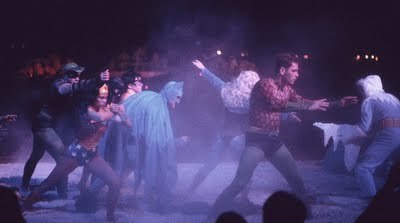 Jeff Parnell: When the fight moved to the stage or beach, Sea World employees would hold up signs that read "POW" and "BANG." Sometimes the adults would laugh hard. We had a couple of talented Jokers. One was a clown for Barnum & Bailey circus. Some of the younger kids would be terrified.
Jeff Parnell: When the fight moved to the stage or beach, Sea World employees would hold up signs that read "POW" and "BANG." Sometimes the adults would laugh hard. We had a couple of talented Jokers. One was a clown for Barnum & Bailey circus. Some of the younger kids would be terrified.
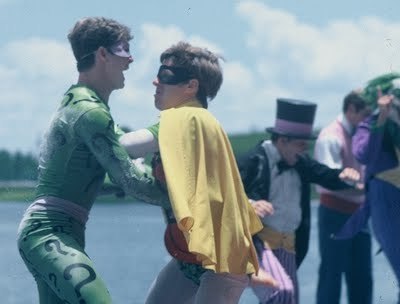 Linda Knapp (Moffett): Catwoman disappeared, Batgirl and Mera got sawed in half, and Robin was put in a torture chamber.
Linda Knapp (Moffett): Catwoman disappeared, Batgirl and Mera got sawed in half, and Robin was put in a torture chamber.
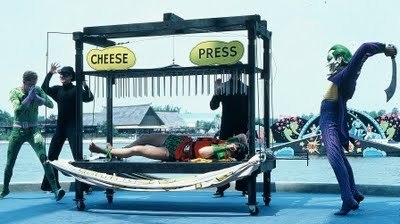 Nancy Radant Combes: There were usually three villains in each show. Joker, Riddler, and Penguin. In the Ohio show we used Catwoman, a non-skiing act.
Nancy Radant Combes: There were usually three villains in each show. Joker, Riddler, and Penguin. In the Ohio show we used Catwoman, a non-skiing act.
If the story changed over time, how so?
Andy Hansen: Some lines here and there. Ken McCabe came on as an announcer. He played the best Joker and was a talented scriptwriter. He and the other announcer would tweak the dialogue.
Shirley Duke: I believe it was tweaked a few times, especially by the hosts, who were pretty creative guys.
Part of the show took place on a stage and a beach. If you had lines during those portions, how did the audience hear you? Were you wearing microphones?
Al Kelley: Voice-overs for all skiers; only Jimmy Olsen (the announcer) and the Joker used mics. It's quite possible that Adam West and others may have been involved in the original recordings for the voice-overs.
Doby Buesse: There were just a few lines for the skiers. No microphones. Lip-synched to the PA. I still remember (as Batman): "Hello there, boys and girls. Are you all having a nice day here at Sea World? That's great!"
Did the characters have different personalities, or were they all simply "good," as was common in superhero cartoons of the period?
Bill Schwartz: It was a little hokey...but fun.
If music accompanied the show, what kind (i.e. existing songs or original songs, rock or classical, etc.?)
Shirley Duke: There was the original Batman theme [and] the [music] from Butch Cassidy & the Sundance Kid, where they are being chased by the posse. When that song came on, we had about 15 minutes to get ready. Some of us waited until the last minute and had to scramble out to the side dock. Sometimes I have nightmares about that song and I wake up laughing.
What was the hardest stunt in the show?
Al Kelley: The ski jumping and back barefoot were the most difficult.
Andy Hansen: Depends who you ask. Carrying those girls on my shoulders as Superman every day seven times a day during the pyramids would remind me that my back wasn't as superheroish as it needed to be. The Penguin's long dive off the ski jump was probably one of the scariest for me at that stage. I learned to enjoy that part in later years.
Bill Peterson: I would say the jump act; others might say star doubles.
Bill Schwartz: The jump act was probably the most difficult and dangerous group act. The back barefoot was the single most difficult act, but we were superheroes and could do anything!
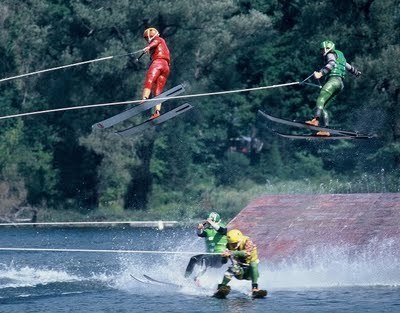 Doby Buesse: For the guys, back barefoot. The girls, star swivel.
Doby Buesse: For the guys, back barefoot. The girls, star swivel.
Jeff Parnell: Jumping at night. The spotlights blinded you.
John Gillette: Though long distance jumping or backward barefooting would typically be considered the hardest, the hardest for me was lead doubles. I was small (140 pounds) and lifting a girl above my head, spinning her around, etc., was a challenge for me.
Lori Taylor: For me, changing clothes in the magic boxes.
Mary McMurtrie: As Wonder Woman, we had to drive a boat over a ramp…which was kinda nerve-racking.
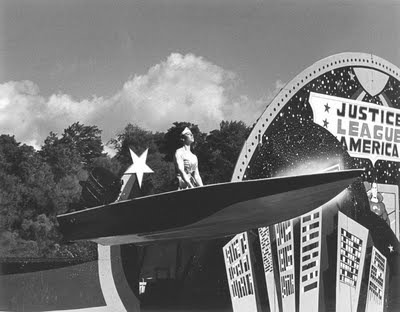 Roland Hillier: Starting off the dock with a skier on your shoulders while wearing a strap around you (not using a handle). There was a person in the boat that would pull a release if you were about to fall. Very intimidating and required a lot of trust with the release puller.
Roland Hillier: Starting off the dock with a skier on your shoulders while wearing a strap around you (not using a handle). There was a person in the boat that would pull a release if you were about to fall. Very intimidating and required a lot of trust with the release puller.
Shirley Duke: I believe the male skiers had the tougher stunts in the show. For the female skiers, if you played Mera or Batgirl, who were sawed in half, you had to curl up your legs and change your tights in the magic boxes while your upper body stayed still. This was after you had just skied. It wasn't hard, just cumbersome.
Suzanne Schwartz: For me, one of the hardest things to master was the dock start—both sitting and standing. There was always something to work on: the skiing, the mechanics of the acts, the various lifts (both on and off the water), choreography, how to set up and break down a show, how to master the costume changes…it was all brand new to me.
Any funny/unusual show anecdotes?
Al Kelley: One of my favorite things after the show was to go out as Superman and while shaking hand with the kids give a real firm handshake. The kids would usually look at each other and say "He really is Superman!"
Andy Hansen: The funniest parts were always undertrained skiers trying to play a superhero. And the magic acts from Harry Blackstone would always provide some funny incidents. One that was frequent was when Catwoman disappeared from the main stage and was supposed to show up on the ski jump when the attention was drawn there. Sometimes she forgot, lost her attention.
Diane Smith: The performers were not shy; they had an excess of personality and spunk. Although we always took our show and practices seriously, I do remember moments of levity. It was my very first day and I was to magically appear as a character who had disappeared from the stage (we had kiosks and "magic boxes" where supposed "sawing" of a character occurred). What actually happened was that tunnels were used for hiding or we would change clothes curled up in the magic boxes. When this character "disappeared," she somehow "reappeared" at the top of the ski jump. But the audience was fooled, as they saw the same costume of the character, but actually a different skier who had been taken to a hiding spot under the ski jump where, upon her cue, she would climb up the jump while the audience was focused elsewhere. Then she would stand and "appear" when the announcer told the audience to look. The audience and the children, especially, were amazed. [So] before the show, I was told, "Don't worry about that funny smell inside the jump where you will be hiding; those moth balls are there to keep the water moccasins out."
Another time, a very sweet female skier was stung by a bee and she continued with the show. However, she was dangerously allergic to bee stings and afterwards was rushed to the hospital for medicine so that she would not go into anaphylactic shock. She could have died if she had waited too long. Her response was, "I knew I had fifteen minutes before it became serious." Most of us had no idea…
Doby Buesse: The multi-swivel was an all-girl ballet-type performance behind one boat. Because they held the rope with their foot, a safety release rider was required to prevent injury if one were to fall. If a fall looked imminent from one skier, a release would be pulled disconnecting all of them from the boat. The flick of a wrist could turn the graceful multi-swivel into a flailing multi-munch. Many of the guys took sadistic pleasure in this. Especially if it was cold out.
Jeff Parnell: We were always playing tricks on each other. Spraying the announcers with the jump boats was one of the most fun. We would drive those jump boats almost on the beach to get to those announcers. It was like we were out of our minds.
Kerry Lloyd: Fontaine did a lot of Batman. He looked like Batman and I did Robin. Part of show was where we take a volunteer in the Batboat. During that we'd get attacked by villains and we'd scare the s*** out of these kids! Nobody from the audience would know what was going on out in that boat. The kids practically cried but not really.
Kerry Lloyd: It was funny every day. We had a guy named John Gaffey who's now deceased (about 1992). He was a natural comedian. He did that Riddler character. He could steal the show at any time. He got reprimanded constantly. Suzie and Sharkey—here's some big characters right there. Sharkey was a star skier and got in a motorcycle accident and hurt his ankle. He moved into maintenance to take care of the boats. So a skier that becomes a supervisor—there's a guy to pick on. [said good-naturedly]
Linda Knapp (Moffett): We were always playing practical jokes on one another, but got in trouble if it negatively affected the show. I remember putting elephant feces in the guys' binders before pyramid…then in the backstretch (the portion of the show circle—the pattern the boat travels in—that goes behind the set so the skiers are out of view of the audience), they dropped us.
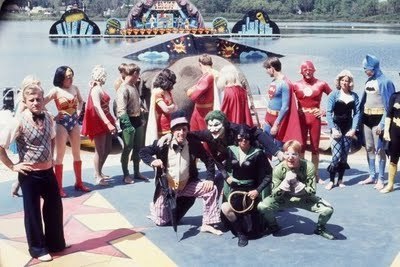 A rare glimpse of Captain Marvel and Mary Marvel
A rare glimpse of Captain Marvel and Mary Marvel
Nancy Radant Combes: Keeping wigs on was always a challenge. Supergirl was particularly tough because she slalomed and had to duck under a rope while crisscrossing across the wake. My friend Janalee got clothes-lined once and she totally lost her wig.
Sherry Wickstrom: The first show I started as Catwoman. To wait for my cue, I hung out by the elephant barn. I would talk to Sunja the elephant while I waited. So another day that I was Catwoman, I walked around the stadium into the park and Sunja was out there with no handler. She recognized either me or the outfit so she started following me. I could not get her into her pen. Then I heard my music cue and I went onto the beach, Sunja right behind me.
Shirley Duke: They [at Sea World] were so meticulous. You were actually part of the comic book. We ruined a whole bunch of costumes by throwing them into the dryer. The Velcro got stuck all over the costumes. They didn't want any photographs taken [until they were fixed]. [Also,] I was in charge of the weight chart; we had weigh-ins every Tuesday. We had an 108-pound limit for the top of the pyramid. Also I was the first female to drive during the show. I was always available to drive during practice when the regular boat drivers were not available.
What was your salary/compensation for performing in the SWSH show?
Al Kelley: $600 to $1,000/month.
Andy Hansen: I calculated 50 cents/hour when I started. LOL! True story.
Betsy Maher (Hawkins): I was an hourly employee. Starting maybe slightly above minimum wage, with health insurance, dental.
Bill Peterson: $4.10/hour starting pay, in 1976 dollars.
Cindy Barhoff (Clasen): The guys made much more. : )
Dave Madeline: Paid hourly. The more stunts you did, the more money you made.
Doby Buesse: When I left in 1981, it was about $8/hour.
Greg Galloway: I think I started out at $6.50/hour, way better than the $2.60 I was earning selling popcorn at Disney.
Janalee Zimmerman (Addleman): I was making $7.30/hour. At that time, that was a lot of money to an 18-year-old (even though I did have to pay for my living expenses)! :-)
Jeff Parnell: Between $8 and $10/hour.
Jody Spence: I think I started at $7/hour.
Kaci Whittenton (Hedstrum): Gosh, I think I started at around $4 and ended up making around $6.50.
Linda Knapp (Moffett): I remember making $800/month, but that changed over the years. It was a decent salary but we worked long hours.
Mary McMurtrie: Not a whole lot. Way under $10/hour.
Nancy Radant Combes: My first summer (1977), I made $3.30/hour. We did 6-7 shows a day.
Paula Nelson (Bloemer): I think about $175 or $200/week.
Randy Messer: I started at $4.35/hour in November 1976. I was paid a bit more than other new skiers because I could back barefoot, jump and perform helicopter spin, and fly a kite.
Roland Hillier: Below industry standards.
Shirley Duke: If you were able to portray all characters, you got the highest compensation.
Steve Fontaine: $650/month.
Suzanne Schwartz: The salary for skiers back in those days was pretty awful. We were paid hourly (not salaried). Can't recall how much but I'm thinking less than $1,500 per month. We did have full benefits that included excellent medical and dental insurance.
Next: skiers, part 5 of 10.

Introduction to subseries "Sea World superheroes show" (including list of interviewees).
Skiers, part 3 of 10.
SWSH = Sea World superheroes
THE SHOW
What was the show's story?
Diane Smith: The story was what you would expect when superheroes and super villains interact. It was the classic good vs. evil scenario. The 45-minute shows were complex, however. So much was happening that one could not watch it all at the same time. There was Jimmy Olsen, the announcer, who described what was taking place on the water as he controlled the action. There were flivers (small boats) and boat drivers waving and circling on the water. "Magic" occurred on the stage with Catwoman and her whip and thugs dressed in black. On the beach, lifts and gymnastic bows were athletically yet delicately completed. There was great excitement on the water as boats approached from all directions and intricate skiing: jumping, doubles, trios, slaloming, shoe skiing, trick skiing, barefoot skiing, and more continued.
 In the air, a kite flier soared as Gary Thompson signaled with his feet to the boat driver and then he made a perfect landing in front of the stands. Boats raced at each other with "near misses." On the diving platform, Tom Kaser climbed higher and higher until he seemed miles up and was finally perched at the top for his high dive into the lake which was flaming with fire. At first, he would not surface and the audience would gasp; then he would appear, smiling and ready to dive again in the next show. Characters would run down the steps in the stands, close enough for the audience to touch them. Some would pretend to be members of the audience and would run onto the set, jump into the water and ski or barefoot. It was genius. In our final stage bow, we signed off as our costumes dictated; only the boat drivers were introduced by their actual names. We even had gorgeous night shows…I remember just about turning purple from the chilling winds in the late December evening shows because we girls did not wear wetsuits, only our regular costumes. To this day, I don't believe there has ever been another [show] to equal it.
In the air, a kite flier soared as Gary Thompson signaled with his feet to the boat driver and then he made a perfect landing in front of the stands. Boats raced at each other with "near misses." On the diving platform, Tom Kaser climbed higher and higher until he seemed miles up and was finally perched at the top for his high dive into the lake which was flaming with fire. At first, he would not surface and the audience would gasp; then he would appear, smiling and ready to dive again in the next show. Characters would run down the steps in the stands, close enough for the audience to touch them. Some would pretend to be members of the audience and would run onto the set, jump into the water and ski or barefoot. It was genius. In our final stage bow, we signed off as our costumes dictated; only the boat drivers were introduced by their actual names. We even had gorgeous night shows…I remember just about turning purple from the chilling winds in the late December evening shows because we girls did not wear wetsuits, only our regular costumes. To this day, I don't believe there has ever been another [show] to equal it. Jeff Parnell: When the fight moved to the stage or beach, Sea World employees would hold up signs that read "POW" and "BANG." Sometimes the adults would laugh hard. We had a couple of talented Jokers. One was a clown for Barnum & Bailey circus. Some of the younger kids would be terrified.
Jeff Parnell: When the fight moved to the stage or beach, Sea World employees would hold up signs that read "POW" and "BANG." Sometimes the adults would laugh hard. We had a couple of talented Jokers. One was a clown for Barnum & Bailey circus. Some of the younger kids would be terrified. Linda Knapp (Moffett): Catwoman disappeared, Batgirl and Mera got sawed in half, and Robin was put in a torture chamber.
Linda Knapp (Moffett): Catwoman disappeared, Batgirl and Mera got sawed in half, and Robin was put in a torture chamber. Nancy Radant Combes: There were usually three villains in each show. Joker, Riddler, and Penguin. In the Ohio show we used Catwoman, a non-skiing act.
Nancy Radant Combes: There were usually three villains in each show. Joker, Riddler, and Penguin. In the Ohio show we used Catwoman, a non-skiing act.If the story changed over time, how so?
Andy Hansen: Some lines here and there. Ken McCabe came on as an announcer. He played the best Joker and was a talented scriptwriter. He and the other announcer would tweak the dialogue.
Shirley Duke: I believe it was tweaked a few times, especially by the hosts, who were pretty creative guys.
Part of the show took place on a stage and a beach. If you had lines during those portions, how did the audience hear you? Were you wearing microphones?
Al Kelley: Voice-overs for all skiers; only Jimmy Olsen (the announcer) and the Joker used mics. It's quite possible that Adam West and others may have been involved in the original recordings for the voice-overs.
Doby Buesse: There were just a few lines for the skiers. No microphones. Lip-synched to the PA. I still remember (as Batman): "Hello there, boys and girls. Are you all having a nice day here at Sea World? That's great!"
Did the characters have different personalities, or were they all simply "good," as was common in superhero cartoons of the period?
Bill Schwartz: It was a little hokey...but fun.
If music accompanied the show, what kind (i.e. existing songs or original songs, rock or classical, etc.?)
Shirley Duke: There was the original Batman theme [and] the [music] from Butch Cassidy & the Sundance Kid, where they are being chased by the posse. When that song came on, we had about 15 minutes to get ready. Some of us waited until the last minute and had to scramble out to the side dock. Sometimes I have nightmares about that song and I wake up laughing.
What was the hardest stunt in the show?
Al Kelley: The ski jumping and back barefoot were the most difficult.
Andy Hansen: Depends who you ask. Carrying those girls on my shoulders as Superman every day seven times a day during the pyramids would remind me that my back wasn't as superheroish as it needed to be. The Penguin's long dive off the ski jump was probably one of the scariest for me at that stage. I learned to enjoy that part in later years.
Bill Peterson: I would say the jump act; others might say star doubles.
Bill Schwartz: The jump act was probably the most difficult and dangerous group act. The back barefoot was the single most difficult act, but we were superheroes and could do anything!
 Doby Buesse: For the guys, back barefoot. The girls, star swivel.
Doby Buesse: For the guys, back barefoot. The girls, star swivel.Jeff Parnell: Jumping at night. The spotlights blinded you.
John Gillette: Though long distance jumping or backward barefooting would typically be considered the hardest, the hardest for me was lead doubles. I was small (140 pounds) and lifting a girl above my head, spinning her around, etc., was a challenge for me.
Lori Taylor: For me, changing clothes in the magic boxes.
Mary McMurtrie: As Wonder Woman, we had to drive a boat over a ramp…which was kinda nerve-racking.
 Roland Hillier: Starting off the dock with a skier on your shoulders while wearing a strap around you (not using a handle). There was a person in the boat that would pull a release if you were about to fall. Very intimidating and required a lot of trust with the release puller.
Roland Hillier: Starting off the dock with a skier on your shoulders while wearing a strap around you (not using a handle). There was a person in the boat that would pull a release if you were about to fall. Very intimidating and required a lot of trust with the release puller.Shirley Duke: I believe the male skiers had the tougher stunts in the show. For the female skiers, if you played Mera or Batgirl, who were sawed in half, you had to curl up your legs and change your tights in the magic boxes while your upper body stayed still. This was after you had just skied. It wasn't hard, just cumbersome.
Suzanne Schwartz: For me, one of the hardest things to master was the dock start—both sitting and standing. There was always something to work on: the skiing, the mechanics of the acts, the various lifts (both on and off the water), choreography, how to set up and break down a show, how to master the costume changes…it was all brand new to me.
Any funny/unusual show anecdotes?
Al Kelley: One of my favorite things after the show was to go out as Superman and while shaking hand with the kids give a real firm handshake. The kids would usually look at each other and say "He really is Superman!"
Andy Hansen: The funniest parts were always undertrained skiers trying to play a superhero. And the magic acts from Harry Blackstone would always provide some funny incidents. One that was frequent was when Catwoman disappeared from the main stage and was supposed to show up on the ski jump when the attention was drawn there. Sometimes she forgot, lost her attention.
Diane Smith: The performers were not shy; they had an excess of personality and spunk. Although we always took our show and practices seriously, I do remember moments of levity. It was my very first day and I was to magically appear as a character who had disappeared from the stage (we had kiosks and "magic boxes" where supposed "sawing" of a character occurred). What actually happened was that tunnels were used for hiding or we would change clothes curled up in the magic boxes. When this character "disappeared," she somehow "reappeared" at the top of the ski jump. But the audience was fooled, as they saw the same costume of the character, but actually a different skier who had been taken to a hiding spot under the ski jump where, upon her cue, she would climb up the jump while the audience was focused elsewhere. Then she would stand and "appear" when the announcer told the audience to look. The audience and the children, especially, were amazed. [So] before the show, I was told, "Don't worry about that funny smell inside the jump where you will be hiding; those moth balls are there to keep the water moccasins out."
Another time, a very sweet female skier was stung by a bee and she continued with the show. However, she was dangerously allergic to bee stings and afterwards was rushed to the hospital for medicine so that she would not go into anaphylactic shock. She could have died if she had waited too long. Her response was, "I knew I had fifteen minutes before it became serious." Most of us had no idea…
Doby Buesse: The multi-swivel was an all-girl ballet-type performance behind one boat. Because they held the rope with their foot, a safety release rider was required to prevent injury if one were to fall. If a fall looked imminent from one skier, a release would be pulled disconnecting all of them from the boat. The flick of a wrist could turn the graceful multi-swivel into a flailing multi-munch. Many of the guys took sadistic pleasure in this. Especially if it was cold out.
Jeff Parnell: We were always playing tricks on each other. Spraying the announcers with the jump boats was one of the most fun. We would drive those jump boats almost on the beach to get to those announcers. It was like we were out of our minds.
Kerry Lloyd: Fontaine did a lot of Batman. He looked like Batman and I did Robin. Part of show was where we take a volunteer in the Batboat. During that we'd get attacked by villains and we'd scare the s*** out of these kids! Nobody from the audience would know what was going on out in that boat. The kids practically cried but not really.
Kerry Lloyd: It was funny every day. We had a guy named John Gaffey who's now deceased (about 1992). He was a natural comedian. He did that Riddler character. He could steal the show at any time. He got reprimanded constantly. Suzie and Sharkey—here's some big characters right there. Sharkey was a star skier and got in a motorcycle accident and hurt his ankle. He moved into maintenance to take care of the boats. So a skier that becomes a supervisor—there's a guy to pick on. [said good-naturedly]
Linda Knapp (Moffett): We were always playing practical jokes on one another, but got in trouble if it negatively affected the show. I remember putting elephant feces in the guys' binders before pyramid…then in the backstretch (the portion of the show circle—the pattern the boat travels in—that goes behind the set so the skiers are out of view of the audience), they dropped us.
 A rare glimpse of Captain Marvel and Mary Marvel
A rare glimpse of Captain Marvel and Mary MarvelNancy Radant Combes: Keeping wigs on was always a challenge. Supergirl was particularly tough because she slalomed and had to duck under a rope while crisscrossing across the wake. My friend Janalee got clothes-lined once and she totally lost her wig.
Sherry Wickstrom: The first show I started as Catwoman. To wait for my cue, I hung out by the elephant barn. I would talk to Sunja the elephant while I waited. So another day that I was Catwoman, I walked around the stadium into the park and Sunja was out there with no handler. She recognized either me or the outfit so she started following me. I could not get her into her pen. Then I heard my music cue and I went onto the beach, Sunja right behind me.
Shirley Duke: They [at Sea World] were so meticulous. You were actually part of the comic book. We ruined a whole bunch of costumes by throwing them into the dryer. The Velcro got stuck all over the costumes. They didn't want any photographs taken [until they were fixed]. [Also,] I was in charge of the weight chart; we had weigh-ins every Tuesday. We had an 108-pound limit for the top of the pyramid. Also I was the first female to drive during the show. I was always available to drive during practice when the regular boat drivers were not available.
What was your salary/compensation for performing in the SWSH show?
Al Kelley: $600 to $1,000/month.
Andy Hansen: I calculated 50 cents/hour when I started. LOL! True story.
Betsy Maher (Hawkins): I was an hourly employee. Starting maybe slightly above minimum wage, with health insurance, dental.
Bill Peterson: $4.10/hour starting pay, in 1976 dollars.
Cindy Barhoff (Clasen): The guys made much more. : )
Dave Madeline: Paid hourly. The more stunts you did, the more money you made.
Doby Buesse: When I left in 1981, it was about $8/hour.
Greg Galloway: I think I started out at $6.50/hour, way better than the $2.60 I was earning selling popcorn at Disney.
Janalee Zimmerman (Addleman): I was making $7.30/hour. At that time, that was a lot of money to an 18-year-old (even though I did have to pay for my living expenses)! :-)
Jeff Parnell: Between $8 and $10/hour.
Jody Spence: I think I started at $7/hour.
Kaci Whittenton (Hedstrum): Gosh, I think I started at around $4 and ended up making around $6.50.
Linda Knapp (Moffett): I remember making $800/month, but that changed over the years. It was a decent salary but we worked long hours.
Mary McMurtrie: Not a whole lot. Way under $10/hour.
Nancy Radant Combes: My first summer (1977), I made $3.30/hour. We did 6-7 shows a day.
Paula Nelson (Bloemer): I think about $175 or $200/week.
Randy Messer: I started at $4.35/hour in November 1976. I was paid a bit more than other new skiers because I could back barefoot, jump and perform helicopter spin, and fly a kite.
Roland Hillier: Below industry standards.
Shirley Duke: If you were able to portray all characters, you got the highest compensation.
Steve Fontaine: $650/month.
Suzanne Schwartz: The salary for skiers back in those days was pretty awful. We were paid hourly (not salaried). Can't recall how much but I'm thinking less than $1,500 per month. We did have full benefits that included excellent medical and dental insurance.
Next: skiers, part 5 of 10.
Published on September 05, 2011 04:14
September 4, 2011
Super '70s and '80s: Sea World superheroes water ski show—the skiers, part 3 of 10
Introduction to series "Super '70s and '80s."
Introduction to subseries "Sea World superheroes show" (including list of interviewees).
Skiers, part 2 of 10.
SWSH = Sea World superheroes
THE COSTUMES
Who made the costumes?
Reyna Blasko: Two designers out of Hollywood. You had to have everything exactly like the comics, body types and all.
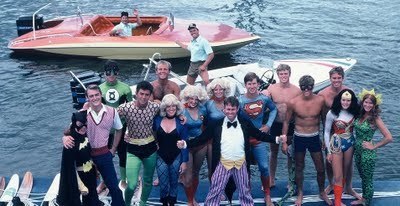 Did you keep any of the costumes?
Did you keep any of the costumes?
Al Kelley: No, I would have liked to but even the well-worn costumes were not allowed to leave.
Andy Hansen: LOL, nope, they would not allow the costumes to be taken from the park. Although it would not surprise me if a couple snuck out. You will have to let me know what you learn here.
Bill Schwartz: Wish I did but unfortunately no. They kept a good eye on them.
Bubby Snow: I did not keep any costumes, but I wish I had some.
Doby Buesse: No, but that Batman costume was the best.
Jacque Cook (Kuntarich): No. We used to have these guys come from Las Vegas who did the showgirls. We would put on a skimpy bathing suit and they'd measure us everywhere. Property of Sea World.
Jeff Parnell: Nobody wanted those flesh-colored spandex tights.
Linda Knapp (Moffett): No, darn it.
Lori Taylor: No though I should have kept one of those bras.
Margie LaPoint (Bates): I never kept any of the costumes (did anybody ever do that?) and I loved the way I felt when wearing them.
Nancy Radant Combes: No, but I heard someone took a Wonder Woman.
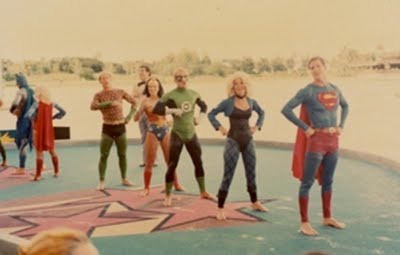 How did you feel dressing like a superhero?
How did you feel dressing like a superhero?
Al Kelley: Great. It was very empowering and very cool meeting the kids when the show was over.
Andy Hansen: Superhuman. During the autograph session especially.
Betsy Maher (Hawkins): More about the skiing than "being a superhero." [Jacque Cook on Betsy: Betsy was the only one who was allowed to do Wonder Woman without a wig. She was the maid of honor at my wedding. For John Macqueen's party, she made CDs of pictures for all of us.]
Bill Schwartz: Really cool. It was like my childhood fantasy to become a superhero.
Bubby Snow: I was used to dressing for shows, but out of all the shows I skied in, this was one of the more prestigious shows. I feel it was one of the best ski shows ever performed at Sea World.
Carl Lipsit: Kind of fun, but still had to wear muscle pads to get into superhero form. At least most of the costumes were tight fitting and didn't drag when they got wet.
Cindy Barhoff (Clasen): Strange at first, however I loved the kids in the audience because they believed we were the real thing. I was a third grade teacher in the area during the year. My students would come to watch the show.
Sherry Wickstrom: We laughed a lot because of the padding for the chest area.
Doby Buesse: It's all about the chest padding. : )
Janalee Zimmerman (Addleman): The whole experience was amazing! I did feel the part! Performing for an audience that size was humbling and awesome at the same time!
Jeff Parnell: Cool for Green Hornet [he later confirmed he meant Green Lantern] and Flash, Robin was okay. The bad guys were fun. A little silly as Superman, with the wig and all.
Jody Spence: Lots of fun, especially Wonder Woman—black hair and I'm blonde.
John Gillette: Sometimes special, sometimes corny.
Kaci Whittenton (Hedstrum): Sometimes silly, especially when taking a bow after a crash landing or wardrobe mishap.
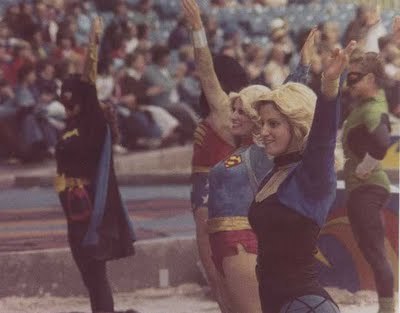 Kerry Lloyd: It was fun. Totally fun. It was a trip.
Kerry Lloyd: It was fun. Totally fun. It was a trip.
Linda Knapp (Moffett): It was a lot of fun. The kids absolutely adored the heroes and it was fun seeing them interact with us after the shows. They really did believe we were the heroes—even my nephew's friend; he had his picture taken with Wonder Woman (who happened to be me that show) and argued with my nephew when my nephew kept calling Wonder Woman "Aunt Linda."
Margie LaPoint (Bates): My perspective of skiing at Sea World was based on the acts of the ski show, having skied at Cypress Gardens and Aqua Follies (another ski show in Fort Myers, Florida). The cartoon theme was not really foremost on my mind.
Mark Gutleben: It built your ego up a little bit.
Nancy Radant Combes: Are you kidding? We all felt like we had super powers.
Paula Nelson (Bloemer): You get used to it.
Randy Messer: Combine heightened awareness, heightened senses, the youth and vitality of a young athlete in front a large crowd displaying a feat that only a few people are capable of performing, and a costume that has been etched in our common psyche to represent extraordinary powers, and for the briefest of moments when the adrenaline spikes and exhilaration floods your body, you [do] feel [like] a superhero. A couple of things I have felt missing in many of the comic books I grew up on was that the writers did not have the superhero display the sheer joy of not only having the power but also the thrill of training. When this happens to a mere mortal, you are literally bouncing with energy. I also felt they missed expressing the many frustrations related to training and the body dealing with pain and aging. Captain America was one of the few that I read which did.
Shirley Duke: Once I put on the costume, wig, and makeup, I was in character. We were critiqued after every show so, for me, it never got to be "routine." Kids in the audience made it enjoyable and worthwhile.
How did the costumes affect your ability to ski?
Al Kelley: No costume problems other than the occasional mask coming off.
Andy Hansen: LOL…some of them. Especially for some people. We had one guy who was too skinny try to play Batman. The cowl over his head would move to the side in the wind and cover his eyes. One time the cape came up over his head. Even better, one time it flew off and revealed his orange carrot top hair. It was soooo funny to us.
Betsy Maher (Hawkins): Capes, masks, and wigs could get in the way.
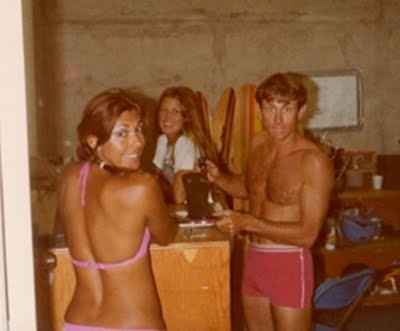 Bill Peterson: None, except sometimes the head gear, like on the Flash, would impair your vision.
Bill Peterson: None, except sometimes the head gear, like on the Flash, would impair your vision.
Janalee Zimmerman (Addleman): The only costume that was at all difficult was the dress for Lois Lane. I had to jump on Clark Kent as he skied by and that was tricky to do in a dress! Two things I hated about skiing at Sea World: one, because your feet were always wet it would be very sore between my toes; two, I hated having to get in the water when it was cold!
John Gillette: No real effect, though we had a significant effect on the costumes. They were very expensive, custom spandex. [Exposure to] 35-40 mph of barefoot "tumbleturns" and other difficult maneuvers often tore them up pretty badly.
Linda Knapp (Moffett): The capes got in the way and were a real drag if they got wet. The wigs had to be maintained and the guys hated to wear them!
Nancy Radant Combes: You did feel like you had a certain responsibility to do your best since you were representing a character that was respected.
Randy Messer: Technically, masks and capes were hindrances; emotionally it had little affect except on rare occasions. Sometimes it may have boosted your self-image. Batman and Flash both had masks and the spandex would pull and lose it elasticity and many times you could only see out of one eye.
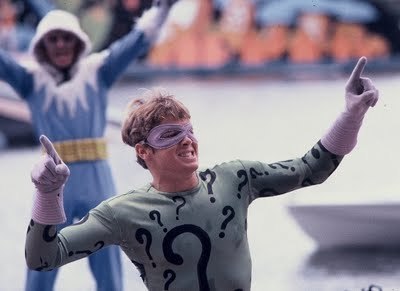 Roland Hillier: Unusual at first because the air against your body without the suits helped with sense of speed.
Roland Hillier: Unusual at first because the air against your body without the suits helped with sense of speed.
Sherry Wickstrom: No problems except for the capes. They were heavy and if you fell you had to get them off before they pulled you down.
Suzanne Schwartz: [At that time,] it was almost impossible to wear a wetsuit under the girls costumes, so during the winters, we froze our tushies off and that definitely hampered our ability. The Batgirl costume was challenging because it was a full headpiece/mask and a huge, heavy cape that weighed a ton when it got wet.
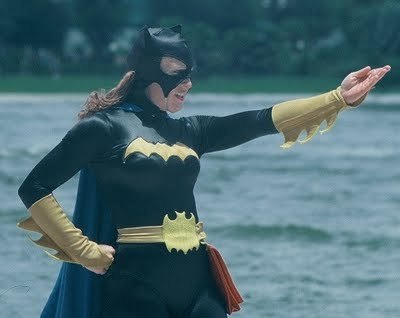 Next: skiers, part 4 of 10.
Next: skiers, part 4 of 10.

Introduction to subseries "Sea World superheroes show" (including list of interviewees).
Skiers, part 2 of 10.
SWSH = Sea World superheroes
THE COSTUMES
Who made the costumes?
Reyna Blasko: Two designers out of Hollywood. You had to have everything exactly like the comics, body types and all.
 Did you keep any of the costumes?
Did you keep any of the costumes?Al Kelley: No, I would have liked to but even the well-worn costumes were not allowed to leave.
Andy Hansen: LOL, nope, they would not allow the costumes to be taken from the park. Although it would not surprise me if a couple snuck out. You will have to let me know what you learn here.
Bill Schwartz: Wish I did but unfortunately no. They kept a good eye on them.
Bubby Snow: I did not keep any costumes, but I wish I had some.
Doby Buesse: No, but that Batman costume was the best.
Jacque Cook (Kuntarich): No. We used to have these guys come from Las Vegas who did the showgirls. We would put on a skimpy bathing suit and they'd measure us everywhere. Property of Sea World.
Jeff Parnell: Nobody wanted those flesh-colored spandex tights.
Linda Knapp (Moffett): No, darn it.
Lori Taylor: No though I should have kept one of those bras.
Margie LaPoint (Bates): I never kept any of the costumes (did anybody ever do that?) and I loved the way I felt when wearing them.
Nancy Radant Combes: No, but I heard someone took a Wonder Woman.
 How did you feel dressing like a superhero?
How did you feel dressing like a superhero?Al Kelley: Great. It was very empowering and very cool meeting the kids when the show was over.
Andy Hansen: Superhuman. During the autograph session especially.
Betsy Maher (Hawkins): More about the skiing than "being a superhero." [Jacque Cook on Betsy: Betsy was the only one who was allowed to do Wonder Woman without a wig. She was the maid of honor at my wedding. For John Macqueen's party, she made CDs of pictures for all of us.]
Bill Schwartz: Really cool. It was like my childhood fantasy to become a superhero.
Bubby Snow: I was used to dressing for shows, but out of all the shows I skied in, this was one of the more prestigious shows. I feel it was one of the best ski shows ever performed at Sea World.
Carl Lipsit: Kind of fun, but still had to wear muscle pads to get into superhero form. At least most of the costumes were tight fitting and didn't drag when they got wet.
Cindy Barhoff (Clasen): Strange at first, however I loved the kids in the audience because they believed we were the real thing. I was a third grade teacher in the area during the year. My students would come to watch the show.
Sherry Wickstrom: We laughed a lot because of the padding for the chest area.
Doby Buesse: It's all about the chest padding. : )
Janalee Zimmerman (Addleman): The whole experience was amazing! I did feel the part! Performing for an audience that size was humbling and awesome at the same time!
Jeff Parnell: Cool for Green Hornet [he later confirmed he meant Green Lantern] and Flash, Robin was okay. The bad guys were fun. A little silly as Superman, with the wig and all.
Jody Spence: Lots of fun, especially Wonder Woman—black hair and I'm blonde.
John Gillette: Sometimes special, sometimes corny.
Kaci Whittenton (Hedstrum): Sometimes silly, especially when taking a bow after a crash landing or wardrobe mishap.
 Kerry Lloyd: It was fun. Totally fun. It was a trip.
Kerry Lloyd: It was fun. Totally fun. It was a trip.Linda Knapp (Moffett): It was a lot of fun. The kids absolutely adored the heroes and it was fun seeing them interact with us after the shows. They really did believe we were the heroes—even my nephew's friend; he had his picture taken with Wonder Woman (who happened to be me that show) and argued with my nephew when my nephew kept calling Wonder Woman "Aunt Linda."
Margie LaPoint (Bates): My perspective of skiing at Sea World was based on the acts of the ski show, having skied at Cypress Gardens and Aqua Follies (another ski show in Fort Myers, Florida). The cartoon theme was not really foremost on my mind.
Mark Gutleben: It built your ego up a little bit.
Nancy Radant Combes: Are you kidding? We all felt like we had super powers.
Paula Nelson (Bloemer): You get used to it.
Randy Messer: Combine heightened awareness, heightened senses, the youth and vitality of a young athlete in front a large crowd displaying a feat that only a few people are capable of performing, and a costume that has been etched in our common psyche to represent extraordinary powers, and for the briefest of moments when the adrenaline spikes and exhilaration floods your body, you [do] feel [like] a superhero. A couple of things I have felt missing in many of the comic books I grew up on was that the writers did not have the superhero display the sheer joy of not only having the power but also the thrill of training. When this happens to a mere mortal, you are literally bouncing with energy. I also felt they missed expressing the many frustrations related to training and the body dealing with pain and aging. Captain America was one of the few that I read which did.
Shirley Duke: Once I put on the costume, wig, and makeup, I was in character. We were critiqued after every show so, for me, it never got to be "routine." Kids in the audience made it enjoyable and worthwhile.
How did the costumes affect your ability to ski?
Al Kelley: No costume problems other than the occasional mask coming off.
Andy Hansen: LOL…some of them. Especially for some people. We had one guy who was too skinny try to play Batman. The cowl over his head would move to the side in the wind and cover his eyes. One time the cape came up over his head. Even better, one time it flew off and revealed his orange carrot top hair. It was soooo funny to us.
Betsy Maher (Hawkins): Capes, masks, and wigs could get in the way.
 Bill Peterson: None, except sometimes the head gear, like on the Flash, would impair your vision.
Bill Peterson: None, except sometimes the head gear, like on the Flash, would impair your vision.Janalee Zimmerman (Addleman): The only costume that was at all difficult was the dress for Lois Lane. I had to jump on Clark Kent as he skied by and that was tricky to do in a dress! Two things I hated about skiing at Sea World: one, because your feet were always wet it would be very sore between my toes; two, I hated having to get in the water when it was cold!
John Gillette: No real effect, though we had a significant effect on the costumes. They were very expensive, custom spandex. [Exposure to] 35-40 mph of barefoot "tumbleturns" and other difficult maneuvers often tore them up pretty badly.
Linda Knapp (Moffett): The capes got in the way and were a real drag if they got wet. The wigs had to be maintained and the guys hated to wear them!
Nancy Radant Combes: You did feel like you had a certain responsibility to do your best since you were representing a character that was respected.
Randy Messer: Technically, masks and capes were hindrances; emotionally it had little affect except on rare occasions. Sometimes it may have boosted your self-image. Batman and Flash both had masks and the spandex would pull and lose it elasticity and many times you could only see out of one eye.
 Roland Hillier: Unusual at first because the air against your body without the suits helped with sense of speed.
Roland Hillier: Unusual at first because the air against your body without the suits helped with sense of speed.Sherry Wickstrom: No problems except for the capes. They were heavy and if you fell you had to get them off before they pulled you down.
Suzanne Schwartz: [At that time,] it was almost impossible to wear a wetsuit under the girls costumes, so during the winters, we froze our tushies off and that definitely hampered our ability. The Batgirl costume was challenging because it was a full headpiece/mask and a huge, heavy cape that weighed a ton when it got wet.
 Next: skiers, part 4 of 10.
Next: skiers, part 4 of 10.
Published on September 04, 2011 04:41
September 3, 2011
Third round of Bill Finger sketches—now in color!
Please come back tomorrow for the continuation of the massive "Super '70s and '80s" series, running most days between now and 10/12/11! And for today, a post of "regularly scheduled content":
In January, I saw Ty Templeton's stellar first sketches for my 2012 picture book on Bill Finger, the uncredited co-creator of Batman.
In March, Charlesbridge sent the first round of revisions.
This month, I received the first color art.
All three sets came postally, not digitally, and all three came in envelopes hand-designed by my peerless editor Alyssa Pusey. This is a testament not only to Alyssa's cleverness but also to the versatility of Batman's iconography.
To recap...
Round 1:
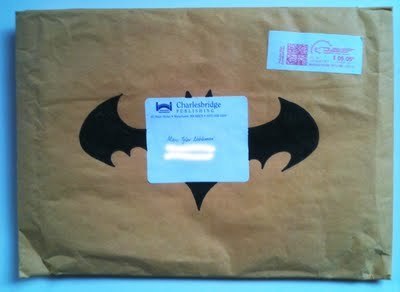 Round 2:
Round 2:
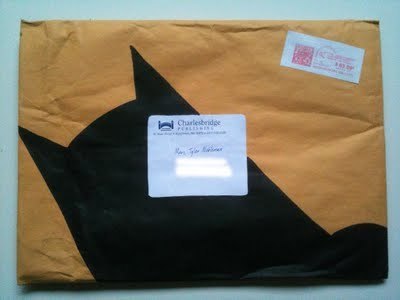 And now, round 3! Drum roll please...
And now, round 3! Drum roll please...
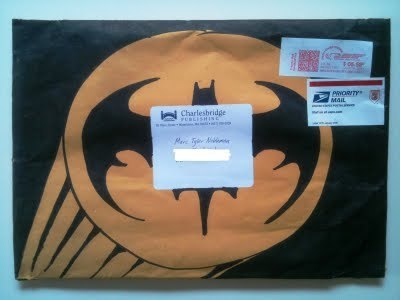 Will there be a round 4, and if so, can Alyssa outdo herself yet again? I'm sure she thrives on the pressure I'm publicly applying!
Will there be a round 4, and if so, can Alyssa outdo herself yet again? I'm sure she thrives on the pressure I'm publicly applying!

In January, I saw Ty Templeton's stellar first sketches for my 2012 picture book on Bill Finger, the uncredited co-creator of Batman.
In March, Charlesbridge sent the first round of revisions.
This month, I received the first color art.
All three sets came postally, not digitally, and all three came in envelopes hand-designed by my peerless editor Alyssa Pusey. This is a testament not only to Alyssa's cleverness but also to the versatility of Batman's iconography.
To recap...
Round 1:
 Round 2:
Round 2: And now, round 3! Drum roll please...
And now, round 3! Drum roll please... Will there be a round 4, and if so, can Alyssa outdo herself yet again? I'm sure she thrives on the pressure I'm publicly applying!
Will there be a round 4, and if so, can Alyssa outdo herself yet again? I'm sure she thrives on the pressure I'm publicly applying!
Published on September 03, 2011 04:08
September 2, 2011
Super '70s and '80s: Sea World superheroes water ski show—the skiers, part 2 of 10
Introduction to series "Super '70s and '80s."
Introduction to subseries "Sea World superheroes show" (including list of interviewees).
Skiers, part 1 of 10.
SWSH = Sea World superheroes
THE CHARACTERS
Which character(s) did you portray?
Al Kelley: Mostly Robin; also played Superman, Green Lantern, Flash, some super villains (Penguin, Riddler, Mr. Freeze, Captain Cold). [NOTE: I haven't seen Mr. Freeze in any photos; Al may be confusing him with Captain Cold.]
Bill Peterson: Because I was 5'5" I could not play characters such as Batman, so I would be Robin. Also the Red Flash, Green Lantern, and the Penguin.
Bill Schwartz: Due to my small size, I tended to play Robin quite a bit. It didn't look good to have a smaller Batman or Superman.
Carl Lipsit: Superman, Perry White, thugs, Batman—probably others but it seems a looooong time ago.
Dave Madeline: I was a boat driver. If a skier got injured, they'd put a driver into a costume until the skier got better. For myself it was a rare occurrence; [at least once] I was a Penguin. You're more valuable as a driver.
Greg Galloway: All the male parts. If Batman was a big guy, I could play Robin. If Robin was a small guy, I could play Batman.
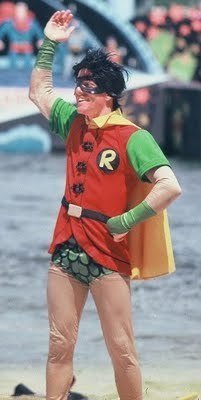 Jacque Cook (Kuntarich): Supergirl was my first but we all did all of them. I was the littlest so I was always on the top of the pyramid.
Jacque Cook (Kuntarich): Supergirl was my first but we all did all of them. I was the littlest so I was always on the top of the pyramid.
Jeff Parnell: Robin, Flash, Green Hornet [he later confirmed he meant Green Lantern], Penguin, Riddler. I was very young and felt silly when I played Superman.
Kerry Lloyd: Everybody but Batman. I'm only five foot four. But I had three Batman costumes for $1,500 apiece. The money they spent on costumes was remarkable. They're stored somewhere [by Sea World]. I bet they're in California. Everybody had three of every costume of every character!
Margie LaPoint (Bates): I can't remember all of the superhero names but I did most all of the acts on a regular basis (except the green costume) [Mera], which was the doubles act, as I was on the big side. I did do that only a few times, but loved it all the same.
Mark Gutleben: I played Aquaman mostly because they had me do the back barefoot all the time. I fell only 11 times out of 250-300 shows. I also played Superman, Robin, Lex Luthor [NOTE: I haven't seen him in any of the photos], Flash, Penguin.
Paula Nelson (Bloemer): Let's see, Mera (I think you have a picture of me winking),Wonder Woman, Batgirl, Catwoman, Supergirl, and Lois Lane.
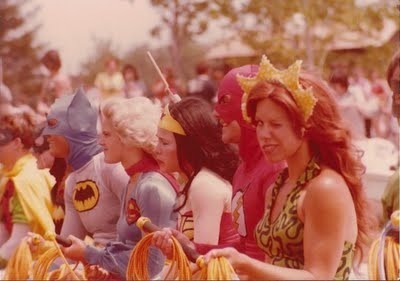 Randy Messer: Lots of Batmans, Aquamans, and Supermans. Batman was an easy ski spot but needed to be taller than Robin. Batman drove the Batboat. He would take a child for a ride. When another skier wanted to prank you, he would find a heavyset child. Batman had to carry the child across beach and place in the boat. Also in the show, Captain Cold would spray Batman with a snow-gun that was a fire extinguisher. Of course skiers loved to overdo it; Batman would be covered in white dust. My lungs are probably damaged from this fun activity. After shows, Batman, Robin, and Wonder Woman would stand outside whether it was 90 or 40 degrees and shake hands. Sometimes you didn't have a good show, maybe falling a few times, and facing the crowd was a bit humiliating, but for the most part the kids made you feel very special.
Randy Messer: Lots of Batmans, Aquamans, and Supermans. Batman was an easy ski spot but needed to be taller than Robin. Batman drove the Batboat. He would take a child for a ride. When another skier wanted to prank you, he would find a heavyset child. Batman had to carry the child across beach and place in the boat. Also in the show, Captain Cold would spray Batman with a snow-gun that was a fire extinguisher. Of course skiers loved to overdo it; Batman would be covered in white dust. My lungs are probably damaged from this fun activity. After shows, Batman, Robin, and Wonder Woman would stand outside whether it was 90 or 40 degrees and shake hands. Sometimes you didn't have a good show, maybe falling a few times, and facing the crowd was a bit humiliating, but for the most part the kids made you feel very special.
There was one skier, Randy Jones, who was as good a Batman figure as any on the big screen.
Aquaman and Superman were in the jump act. I was the first skier to perform a gainer off the jump (skiing forward and performing a back flip). My wife Robbi (just dating back then) says she was first attracted to me when I did gainers as Superman.
A tall, skinny, red-headed skier named John Gaffey wanted so much to be Superman. His skiing skills were inconsistent but his comedic timing flawless. He was Superman once and fell in the shallow surf coming in on parade—the show opener when all the heroes were introduced. When he arose, the cape was wrapped around him, he held the black wig, his tights were down to his knees, and he was covered in sand. With a straight face, the announcer presented the Man of Steel to a dismayed crowd of kids.
Superman also played Perry White in comedy doubles. A girl jumped on your back as you skied by a dock. (The girl was often one of the trainees because it didn't require skiing skills and in the end the girl was tossed into the water.) Girls hated seeing Lois Lane by their name on the show schedule.
No one liked doing the Flash because of the shoe ski act which never garnered much respect from other skiers even if you were good at it, and most of us weren't and there were often falls and the following act would be coming in so if you fell you had to swim like crazy to get out of the way.
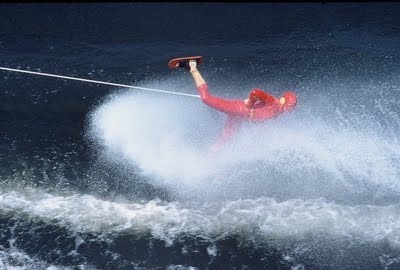 Green Lantern was fun and the costume was great because there was no mask [NOTE: photos show there was], cape, or wig—just a plastic ring. Easy skiing and you always won the jump boat race, even if your boat was not running very well.
Green Lantern was fun and the costume was great because there was no mask [NOTE: photos show there was], cape, or wig—just a plastic ring. Easy skiing and you always won the jump boat race, even if your boat was not running very well.
Green Arrow was a high diver (literally, when it was [name redacted, but not Dan Poor!]). He dove from 70 feet into fire. The diver would walk in a few minutes before the show, do his one dive, then leave. We kind of envied his schedule and some skiers attempted to learn to dive.
Penguin wore a padded stomach and rubber nose. Wonder Woman would catch you and the challenge was to make Wonder Woman lose her composure as she was delivering her serious lines about her magic lasso. Many unusual comments were whispered as Penguin kneeled beside Wonder Woman.
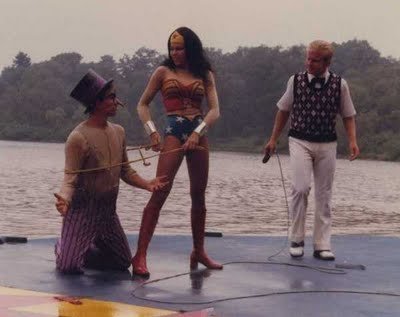
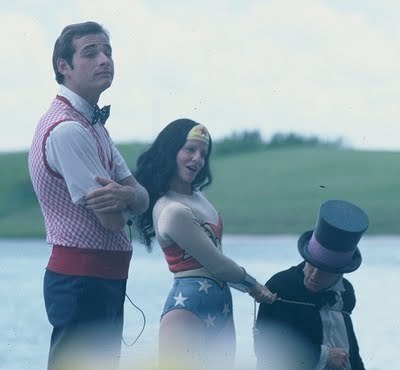 Steve Fontaine: In the very first show in Ohio, I was the first water ski act, portraying the paperboy. I skied by the audience screaming "Extra, extra, read all about it!" And that began the superhero show! My next act was Superman! Then at various times I played Batman, Robin, Aquaman, Green Lantern, and thugs.
Steve Fontaine: In the very first show in Ohio, I was the first water ski act, portraying the paperboy. I skied by the audience screaming "Extra, extra, read all about it!" And that began the superhero show! My next act was Superman! Then at various times I played Batman, Robin, Aquaman, Green Lantern, and thugs.
Which characters did you prefer to portray and why?
Al Kelley: Robin was fun but I liked to play Penguin so I could do the beach barefoot. [This was] water skiing on your bare feet—[meaning] without skis.
Andy Hansen: Aquaman. He got to do the more difficult water ski tricks. Although Batman was the most fun because the audience's, especially the kids', eyeballs would pop out of their heads during the post-show autograph sessions. In my opinion, Batman had the most authentic-looking costume. Superman's was also great, but I did not have black hair. I had to wear a dumb wig.
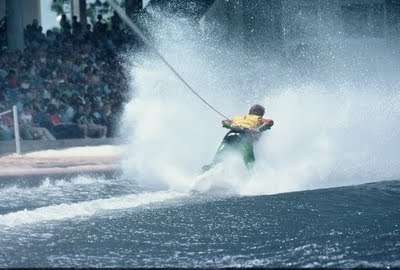 Betsy Maher (Hawkins): Lois Lane (the comedy act) was fun.
Betsy Maher (Hawkins): Lois Lane (the comedy act) was fun.
Bubby Snow: I enjoyed playing Superman, even though it did not require the more difficult water skiing stunts. I liked playing Aquaman because it was the more challenging water skiing stunts.
Carl Lipsit: Batman/Perry White. In those roles, you worked in a harness and/or performed lifts and other acts with a partner.
Cindy Barhoff (Clasen): I preferred Supergirl because I got to slalom and ski around the boat. I also liked Lois Lane because it was a comedy act. I was terribly shy in high school and I surprised myself when I was in that costume. New outfit…new personality!
Diane Smith: I thoroughly enjoyed being Supergirl because she seemed to best fit my size and exemplify my personality.
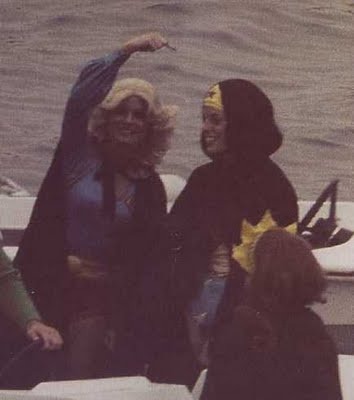 Either she or Wonder Woman climbed to the top of the pyramid, and I was small enough to be carried by the taller girls as "top girl." Believe it or not, my part was easy; I did it so often that I never worried about it. Actually, the girls on whose shoulders I stood had the more difficult time because they supported my weight and secured my flag; then they helped me as I climbed down to the "middle man" who skied me to the beach while I stood on the top front of his skis. The female skiers were expected to weigh less than 110 pounds and preferably to be around 100 pounds (although for the tallest girls, who did not do the lifts, go to the top of the pyramid, or contort themselves in the magic boxes, there were exceptions).
Either she or Wonder Woman climbed to the top of the pyramid, and I was small enough to be carried by the taller girls as "top girl." Believe it or not, my part was easy; I did it so often that I never worried about it. Actually, the girls on whose shoulders I stood had the more difficult time because they supported my weight and secured my flag; then they helped me as I climbed down to the "middle man" who skied me to the beach while I stood on the top front of his skis. The female skiers were expected to weigh less than 110 pounds and preferably to be around 100 pounds (although for the tallest girls, who did not do the lifts, go to the top of the pyramid, or contort themselves in the magic boxes, there were exceptions).
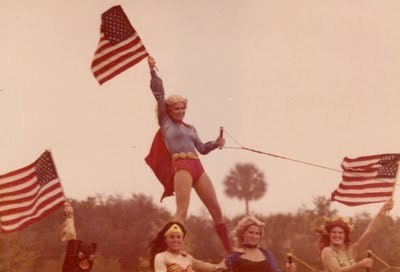 Doby Buesse: The Penguin. A relatively easy but crowd pleasing act. You got to drive the small clown boat. You also could act silly on stage and perform the beach barefoot. The beach barefoot was a ski act. The Penguin (in an attempt to avoid the Dynamic Duo smackdown on the stage) would run down the beach and grab the ski handle, wherein the boat would take off. He would slide off the beach on his butt and then barefoot ski around the lake. After throwing the rope and sliding back up onto the beach, the Penguin would proclaim to the announcer (Jimmy Olsen) that he was the best barefoot skier in the world. This is when Wonder Woman and her "Truth Lasso" would make an appearance. "Curses, foiled again. The greatest barefoot water skier is…Aquaman." Aquaman would take his queue and perform the backwards barefoot.
Doby Buesse: The Penguin. A relatively easy but crowd pleasing act. You got to drive the small clown boat. You also could act silly on stage and perform the beach barefoot. The beach barefoot was a ski act. The Penguin (in an attempt to avoid the Dynamic Duo smackdown on the stage) would run down the beach and grab the ski handle, wherein the boat would take off. He would slide off the beach on his butt and then barefoot ski around the lake. After throwing the rope and sliding back up onto the beach, the Penguin would proclaim to the announcer (Jimmy Olsen) that he was the best barefoot skier in the world. This is when Wonder Woman and her "Truth Lasso" would make an appearance. "Curses, foiled again. The greatest barefoot water skier is…Aquaman." Aquaman would take his queue and perform the backwards barefoot.
Gary Thompson (who was also a show manager): I liked the Flash for the costume, the character, and the acts in the show that he did.
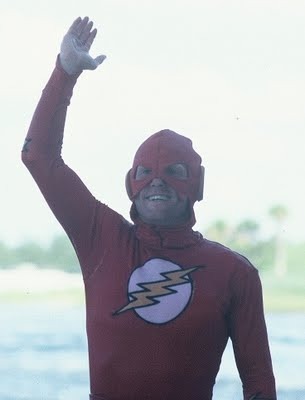 Jacque Cook (Kuntarich): My favorite act was doubles, or adagio (where the guy lifts the girl above his head). That was usually Aquaman and Mera. You'd go into work and your name would have a number next to it, 1 for Wonder Wonder, 2 Mera, 3 or 4 was Batgirl, and so on; 8 was Lois Lane which was the comedy act. I mostly played more star acts. The big show was the 1 o'clock.
Jacque Cook (Kuntarich): My favorite act was doubles, or adagio (where the guy lifts the girl above his head). That was usually Aquaman and Mera. You'd go into work and your name would have a number next to it, 1 for Wonder Wonder, 2 Mera, 3 or 4 was Batgirl, and so on; 8 was Lois Lane which was the comedy act. I mostly played more star acts. The big show was the 1 o'clock.
Jeff Parnell: Green Hornet [he later confirmed he meant Green Lantern]. It was a cool costume and you got to do cool acts like boat jumping and ski jumping.
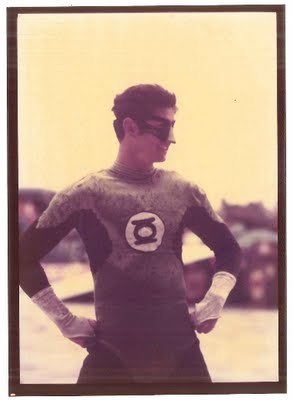 John Gillette: Aquaman was the lead ski 1 position and did the backward barefooting, which was my specialty.
John Gillette: Aquaman was the lead ski 1 position and did the backward barefooting, which was my specialty.
Linda Knapp (Moffett): There were quite a few that were outstanding, but for different reasons. Catwoman was fun because it was a dry act and she came in from the side of the stadium giving you a chance to stop and visit Sunja (the elephant) and check out the crowd before going on stage. Her costume was very cool with the mask, boots, and whip. It was also fun disappearing on stage—a real crowd pleaser!
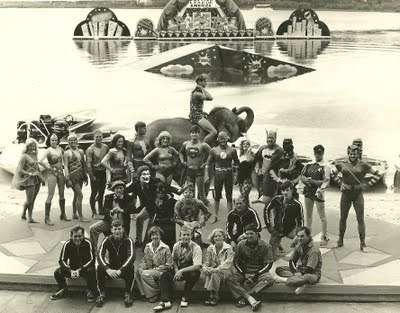 A rare glimpse of Captain Marvel and Mary Marvel
A rare glimpse of Captain Marvel and Mary Marvel
Supergirl was fun because you landed on the beach and talked with the announcer. The year we had the wet bike [NOTE: described as cross between motorcycle and jet ski], most of the time you landed on the beach was a real challenge. The wet bike was big and heavy and hard for the girls to handle. If you landed it on the beach too far up, you couldn't push it back into the water—which was embarrassing because, after all, you were Supergirl. If you landed it too deep, you had to drag yourself up through deep water with a dripping wet cape.
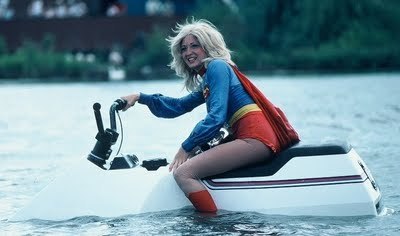 Mera was fun because I liked doing doubles and her costume didn't have an annoying cape. Wonder Woman was the crowd favorite and was the star of the show. She was awesome.
Mera was fun because I liked doing doubles and her costume didn't have an annoying cape. Wonder Woman was the crowd favorite and was the star of the show. She was awesome.
Margie LaPoint (Bates): I loved being Wonder Woman and did it sometimes but not always because Wonder Woman climbed to the top of the pyramid and I was considered big for that. I went through a starvation period in my life and got down to 110 pounds, which was the cutoff for doing both of those acts, which was why I was able to do them at all! (I do not recommend it to any young girls.)
Mary McMurtrie: Wonder Woman…I think you actually felt the power in that costume.
Paula Nelson (Bloemer): Each of the roles had their advantages and disadvantages. Mera and Batgirl had to be chopped in half—which involved lying in a cramped box on stage in the blistering summer heat while changing (actually putting on an additional costume half). At least Mera didn't have a face mask and cape. Wonder Woman got to jump the boat through the set and save the day and also had a sort of ski solo on swivel. She was fun to play if everything went well. It certainly was a rush jumping boats. Prior to that summer, the only boats I navigated were canoes! Sometimes it was fun to play the villain, Catwoman—that is, once you got the hang of cracking a real 10' or so leather bullwhip without zapping the audience, Blue [sic] Canary, or yourself in the face.
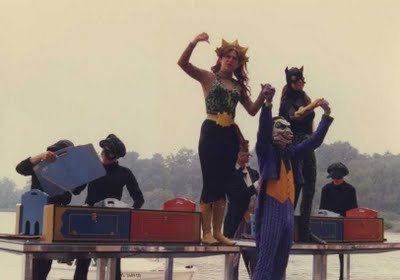
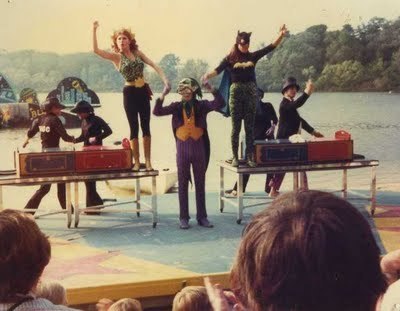 Shirley Duke: My favorites were Wonder Woman, Lois Lane, and Catwoman. I was awesome with the bull whip.
Shirley Duke: My favorites were Wonder Woman, Lois Lane, and Catwoman. I was awesome with the bull whip.
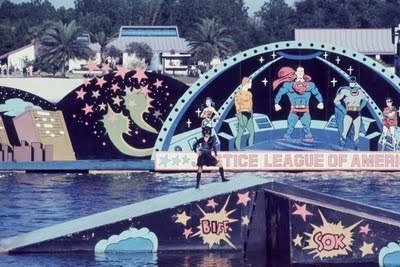 Catwoman
Catwoman
Suzanne Schwartz: I liked being Supergirl because the costume was cute and I liked the acts she was involved with—performing the doubles, as an example. I also like being Catwoman because the costume was slinky and sexy.
Which characters, if any, were more in demand among the performers to portray?
Al Kelley: Aquaman for the backwards barefoot and Flash who flew the kite.
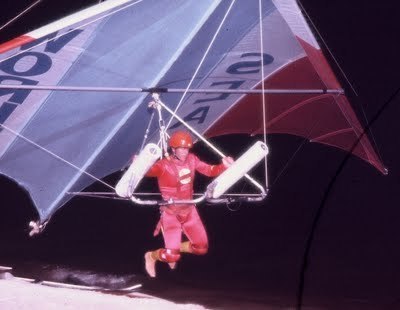 Andy Hansen: Aquaman. That was the ski 1 position. It took the most water ski talent to perform.
Andy Hansen: Aquaman. That was the ski 1 position. It took the most water ski talent to perform.
Bill Peterson: I would say the characters that did star doubles. [NOTE: Star doubles was when an accomplished male and female skier performed a doubles routine together. The boy did lifts with the girl. Only the strongest boys got to do it. It was an honor to get this position.] It took strength, good skiing skills, and balance.
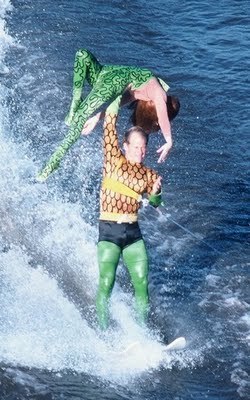 Bill Schwartz: The big stars of the show were Batman, Robin, and Superman for the men and Supergirl, Wonder Woman, and Batgirl for the girls. Villains were always fun. The Joker had a big part and was a crowd pleaser. The Joker was an actor who performed only on the stage and was not a skier.
Bill Schwartz: The big stars of the show were Batman, Robin, and Superman for the men and Supergirl, Wonder Woman, and Batgirl for the girls. Villains were always fun. The Joker had a big part and was a crowd pleaser. The Joker was an actor who performed only on the stage and was not a skier.
Carl Lipsit: I don't remember competition for particular roles among the men. Some had height restrictions. I was too tall to play the Penguin or Robin.
Dave Madeline: Batman, Superman. Kids were going nuts. After the shows there were kids hanging all over the place looking for the superheroes. After a while Sea World realized this was a great op to get the PR they were looking for so they had skiers go out and rub flesh, meet the kids after the show. Now it means something. Back then we were just kids.
Doby Buesse: The acts were set up by difficulty 1-8 (1 being the hardest). Aquaman was the "1"—backward barefoot and star doubles. The Riddler was "8"—I don't think he even got wet. The girls had difficulty scale, too, but I don't remember it.
The scale, as Doby remembers:
1 Aquaman
2 Flash
3 Green Lantern
4 Superman
5 Batman
6 Robin
7 Penguin
8 Riddler
Gary Thompson: The stars, of course, were Wonder Woman and I suppose Batman and Robin. Superman and Supergirl were cool, and so was Aquaman and Mera, and the Joker was the best villain, along with the Penguin, Catwoman, and the Riddler.
Janalee Zimmerman (Addleman): I think Wonder Woman was the most prestigious character to play. First of all, she was gorgeous and also she skied alone as a feature in the show. She used the swivel ski and it was impressive! I did not ever play that part. The swivel ski was the same and I never did master that feat! Also, I wasn't built tall and thin like the girl who played her was! I think her first name was Kaci. She was fabulous.
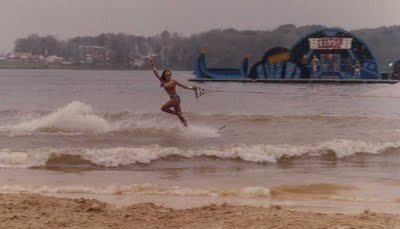
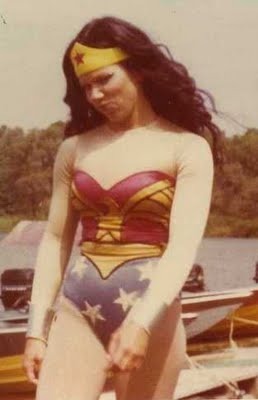
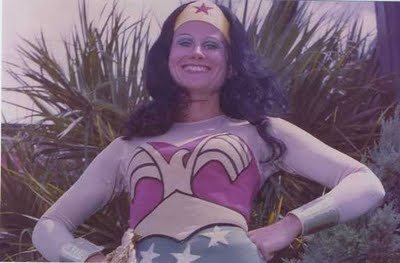 Nancy Radant Combes: Each character was attached to a specific act that required a certain talent. Some acts were more difficult than others. Black Canary was probably the easiest, then Batgirl and Supergirl, then Mera, then Wonder Woman.
Nancy Radant Combes: Each character was attached to a specific act that required a certain talent. Some acts were more difficult than others. Black Canary was probably the easiest, then Batgirl and Supergirl, then Mera, then Wonder Woman.
Steve Fontaine: The crowd loved Batman and Robin. They also loved Aquaman, Flash, and Green Arrow.
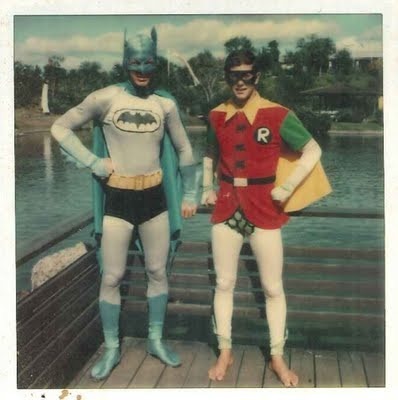 Suzanne Schwartz: I think for the gals, Wonder Woman was probably the popular character. It was a great-looking costume and the character was very well known. Wonder Woman also got to perform solo swivel—the only solo act for the girls—so Wonder Woman was the act you'd hope for, particularly if you had friends or family coming.
Suzanne Schwartz: I think for the gals, Wonder Woman was probably the popular character. It was a great-looking costume and the character was very well known. Wonder Woman also got to perform solo swivel—the only solo act for the girls—so Wonder Woman was the act you'd hope for, particularly if you had friends or family coming.
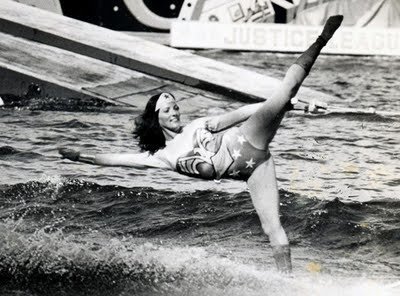 Tom Weber: Aquaman. He appeared in the highest number of acts.
Tom Weber: Aquaman. He appeared in the highest number of acts.
Did you portray any characters that you hadn't heard of before?
[Most who answered said Black Canary, Mera, or both.]
Next: skiers, part 3 of 10.

Introduction to subseries "Sea World superheroes show" (including list of interviewees).
Skiers, part 1 of 10.
SWSH = Sea World superheroes
THE CHARACTERS
Which character(s) did you portray?
Al Kelley: Mostly Robin; also played Superman, Green Lantern, Flash, some super villains (Penguin, Riddler, Mr. Freeze, Captain Cold). [NOTE: I haven't seen Mr. Freeze in any photos; Al may be confusing him with Captain Cold.]
Bill Peterson: Because I was 5'5" I could not play characters such as Batman, so I would be Robin. Also the Red Flash, Green Lantern, and the Penguin.
Bill Schwartz: Due to my small size, I tended to play Robin quite a bit. It didn't look good to have a smaller Batman or Superman.
Carl Lipsit: Superman, Perry White, thugs, Batman—probably others but it seems a looooong time ago.
Dave Madeline: I was a boat driver. If a skier got injured, they'd put a driver into a costume until the skier got better. For myself it was a rare occurrence; [at least once] I was a Penguin. You're more valuable as a driver.
Greg Galloway: All the male parts. If Batman was a big guy, I could play Robin. If Robin was a small guy, I could play Batman.
 Jacque Cook (Kuntarich): Supergirl was my first but we all did all of them. I was the littlest so I was always on the top of the pyramid.
Jacque Cook (Kuntarich): Supergirl was my first but we all did all of them. I was the littlest so I was always on the top of the pyramid.Jeff Parnell: Robin, Flash, Green Hornet [he later confirmed he meant Green Lantern], Penguin, Riddler. I was very young and felt silly when I played Superman.
Kerry Lloyd: Everybody but Batman. I'm only five foot four. But I had three Batman costumes for $1,500 apiece. The money they spent on costumes was remarkable. They're stored somewhere [by Sea World]. I bet they're in California. Everybody had three of every costume of every character!
Margie LaPoint (Bates): I can't remember all of the superhero names but I did most all of the acts on a regular basis (except the green costume) [Mera], which was the doubles act, as I was on the big side. I did do that only a few times, but loved it all the same.
Mark Gutleben: I played Aquaman mostly because they had me do the back barefoot all the time. I fell only 11 times out of 250-300 shows. I also played Superman, Robin, Lex Luthor [NOTE: I haven't seen him in any of the photos], Flash, Penguin.
Paula Nelson (Bloemer): Let's see, Mera (I think you have a picture of me winking),Wonder Woman, Batgirl, Catwoman, Supergirl, and Lois Lane.
 Randy Messer: Lots of Batmans, Aquamans, and Supermans. Batman was an easy ski spot but needed to be taller than Robin. Batman drove the Batboat. He would take a child for a ride. When another skier wanted to prank you, he would find a heavyset child. Batman had to carry the child across beach and place in the boat. Also in the show, Captain Cold would spray Batman with a snow-gun that was a fire extinguisher. Of course skiers loved to overdo it; Batman would be covered in white dust. My lungs are probably damaged from this fun activity. After shows, Batman, Robin, and Wonder Woman would stand outside whether it was 90 or 40 degrees and shake hands. Sometimes you didn't have a good show, maybe falling a few times, and facing the crowd was a bit humiliating, but for the most part the kids made you feel very special.
Randy Messer: Lots of Batmans, Aquamans, and Supermans. Batman was an easy ski spot but needed to be taller than Robin. Batman drove the Batboat. He would take a child for a ride. When another skier wanted to prank you, he would find a heavyset child. Batman had to carry the child across beach and place in the boat. Also in the show, Captain Cold would spray Batman with a snow-gun that was a fire extinguisher. Of course skiers loved to overdo it; Batman would be covered in white dust. My lungs are probably damaged from this fun activity. After shows, Batman, Robin, and Wonder Woman would stand outside whether it was 90 or 40 degrees and shake hands. Sometimes you didn't have a good show, maybe falling a few times, and facing the crowd was a bit humiliating, but for the most part the kids made you feel very special.There was one skier, Randy Jones, who was as good a Batman figure as any on the big screen.
Aquaman and Superman were in the jump act. I was the first skier to perform a gainer off the jump (skiing forward and performing a back flip). My wife Robbi (just dating back then) says she was first attracted to me when I did gainers as Superman.
A tall, skinny, red-headed skier named John Gaffey wanted so much to be Superman. His skiing skills were inconsistent but his comedic timing flawless. He was Superman once and fell in the shallow surf coming in on parade—the show opener when all the heroes were introduced. When he arose, the cape was wrapped around him, he held the black wig, his tights were down to his knees, and he was covered in sand. With a straight face, the announcer presented the Man of Steel to a dismayed crowd of kids.
Superman also played Perry White in comedy doubles. A girl jumped on your back as you skied by a dock. (The girl was often one of the trainees because it didn't require skiing skills and in the end the girl was tossed into the water.) Girls hated seeing Lois Lane by their name on the show schedule.
No one liked doing the Flash because of the shoe ski act which never garnered much respect from other skiers even if you were good at it, and most of us weren't and there were often falls and the following act would be coming in so if you fell you had to swim like crazy to get out of the way.
 Green Lantern was fun and the costume was great because there was no mask [NOTE: photos show there was], cape, or wig—just a plastic ring. Easy skiing and you always won the jump boat race, even if your boat was not running very well.
Green Lantern was fun and the costume was great because there was no mask [NOTE: photos show there was], cape, or wig—just a plastic ring. Easy skiing and you always won the jump boat race, even if your boat was not running very well.Green Arrow was a high diver (literally, when it was [name redacted, but not Dan Poor!]). He dove from 70 feet into fire. The diver would walk in a few minutes before the show, do his one dive, then leave. We kind of envied his schedule and some skiers attempted to learn to dive.
Penguin wore a padded stomach and rubber nose. Wonder Woman would catch you and the challenge was to make Wonder Woman lose her composure as she was delivering her serious lines about her magic lasso. Many unusual comments were whispered as Penguin kneeled beside Wonder Woman.

 Steve Fontaine: In the very first show in Ohio, I was the first water ski act, portraying the paperboy. I skied by the audience screaming "Extra, extra, read all about it!" And that began the superhero show! My next act was Superman! Then at various times I played Batman, Robin, Aquaman, Green Lantern, and thugs.
Steve Fontaine: In the very first show in Ohio, I was the first water ski act, portraying the paperboy. I skied by the audience screaming "Extra, extra, read all about it!" And that began the superhero show! My next act was Superman! Then at various times I played Batman, Robin, Aquaman, Green Lantern, and thugs.Which characters did you prefer to portray and why?
Al Kelley: Robin was fun but I liked to play Penguin so I could do the beach barefoot. [This was] water skiing on your bare feet—[meaning] without skis.
Andy Hansen: Aquaman. He got to do the more difficult water ski tricks. Although Batman was the most fun because the audience's, especially the kids', eyeballs would pop out of their heads during the post-show autograph sessions. In my opinion, Batman had the most authentic-looking costume. Superman's was also great, but I did not have black hair. I had to wear a dumb wig.
 Betsy Maher (Hawkins): Lois Lane (the comedy act) was fun.
Betsy Maher (Hawkins): Lois Lane (the comedy act) was fun. Bubby Snow: I enjoyed playing Superman, even though it did not require the more difficult water skiing stunts. I liked playing Aquaman because it was the more challenging water skiing stunts.
Carl Lipsit: Batman/Perry White. In those roles, you worked in a harness and/or performed lifts and other acts with a partner.
Cindy Barhoff (Clasen): I preferred Supergirl because I got to slalom and ski around the boat. I also liked Lois Lane because it was a comedy act. I was terribly shy in high school and I surprised myself when I was in that costume. New outfit…new personality!
Diane Smith: I thoroughly enjoyed being Supergirl because she seemed to best fit my size and exemplify my personality.
 Either she or Wonder Woman climbed to the top of the pyramid, and I was small enough to be carried by the taller girls as "top girl." Believe it or not, my part was easy; I did it so often that I never worried about it. Actually, the girls on whose shoulders I stood had the more difficult time because they supported my weight and secured my flag; then they helped me as I climbed down to the "middle man" who skied me to the beach while I stood on the top front of his skis. The female skiers were expected to weigh less than 110 pounds and preferably to be around 100 pounds (although for the tallest girls, who did not do the lifts, go to the top of the pyramid, or contort themselves in the magic boxes, there were exceptions).
Either she or Wonder Woman climbed to the top of the pyramid, and I was small enough to be carried by the taller girls as "top girl." Believe it or not, my part was easy; I did it so often that I never worried about it. Actually, the girls on whose shoulders I stood had the more difficult time because they supported my weight and secured my flag; then they helped me as I climbed down to the "middle man" who skied me to the beach while I stood on the top front of his skis. The female skiers were expected to weigh less than 110 pounds and preferably to be around 100 pounds (although for the tallest girls, who did not do the lifts, go to the top of the pyramid, or contort themselves in the magic boxes, there were exceptions). Doby Buesse: The Penguin. A relatively easy but crowd pleasing act. You got to drive the small clown boat. You also could act silly on stage and perform the beach barefoot. The beach barefoot was a ski act. The Penguin (in an attempt to avoid the Dynamic Duo smackdown on the stage) would run down the beach and grab the ski handle, wherein the boat would take off. He would slide off the beach on his butt and then barefoot ski around the lake. After throwing the rope and sliding back up onto the beach, the Penguin would proclaim to the announcer (Jimmy Olsen) that he was the best barefoot skier in the world. This is when Wonder Woman and her "Truth Lasso" would make an appearance. "Curses, foiled again. The greatest barefoot water skier is…Aquaman." Aquaman would take his queue and perform the backwards barefoot.
Doby Buesse: The Penguin. A relatively easy but crowd pleasing act. You got to drive the small clown boat. You also could act silly on stage and perform the beach barefoot. The beach barefoot was a ski act. The Penguin (in an attempt to avoid the Dynamic Duo smackdown on the stage) would run down the beach and grab the ski handle, wherein the boat would take off. He would slide off the beach on his butt and then barefoot ski around the lake. After throwing the rope and sliding back up onto the beach, the Penguin would proclaim to the announcer (Jimmy Olsen) that he was the best barefoot skier in the world. This is when Wonder Woman and her "Truth Lasso" would make an appearance. "Curses, foiled again. The greatest barefoot water skier is…Aquaman." Aquaman would take his queue and perform the backwards barefoot.Gary Thompson (who was also a show manager): I liked the Flash for the costume, the character, and the acts in the show that he did.
 Jacque Cook (Kuntarich): My favorite act was doubles, or adagio (where the guy lifts the girl above his head). That was usually Aquaman and Mera. You'd go into work and your name would have a number next to it, 1 for Wonder Wonder, 2 Mera, 3 or 4 was Batgirl, and so on; 8 was Lois Lane which was the comedy act. I mostly played more star acts. The big show was the 1 o'clock.
Jacque Cook (Kuntarich): My favorite act was doubles, or adagio (where the guy lifts the girl above his head). That was usually Aquaman and Mera. You'd go into work and your name would have a number next to it, 1 for Wonder Wonder, 2 Mera, 3 or 4 was Batgirl, and so on; 8 was Lois Lane which was the comedy act. I mostly played more star acts. The big show was the 1 o'clock.Jeff Parnell: Green Hornet [he later confirmed he meant Green Lantern]. It was a cool costume and you got to do cool acts like boat jumping and ski jumping.
 John Gillette: Aquaman was the lead ski 1 position and did the backward barefooting, which was my specialty.
John Gillette: Aquaman was the lead ski 1 position and did the backward barefooting, which was my specialty.Linda Knapp (Moffett): There were quite a few that were outstanding, but for different reasons. Catwoman was fun because it was a dry act and she came in from the side of the stadium giving you a chance to stop and visit Sunja (the elephant) and check out the crowd before going on stage. Her costume was very cool with the mask, boots, and whip. It was also fun disappearing on stage—a real crowd pleaser!
 A rare glimpse of Captain Marvel and Mary Marvel
A rare glimpse of Captain Marvel and Mary MarvelSupergirl was fun because you landed on the beach and talked with the announcer. The year we had the wet bike [NOTE: described as cross between motorcycle and jet ski], most of the time you landed on the beach was a real challenge. The wet bike was big and heavy and hard for the girls to handle. If you landed it on the beach too far up, you couldn't push it back into the water—which was embarrassing because, after all, you were Supergirl. If you landed it too deep, you had to drag yourself up through deep water with a dripping wet cape.
 Mera was fun because I liked doing doubles and her costume didn't have an annoying cape. Wonder Woman was the crowd favorite and was the star of the show. She was awesome.
Mera was fun because I liked doing doubles and her costume didn't have an annoying cape. Wonder Woman was the crowd favorite and was the star of the show. She was awesome.Margie LaPoint (Bates): I loved being Wonder Woman and did it sometimes but not always because Wonder Woman climbed to the top of the pyramid and I was considered big for that. I went through a starvation period in my life and got down to 110 pounds, which was the cutoff for doing both of those acts, which was why I was able to do them at all! (I do not recommend it to any young girls.)
Mary McMurtrie: Wonder Woman…I think you actually felt the power in that costume.
Paula Nelson (Bloemer): Each of the roles had their advantages and disadvantages. Mera and Batgirl had to be chopped in half—which involved lying in a cramped box on stage in the blistering summer heat while changing (actually putting on an additional costume half). At least Mera didn't have a face mask and cape. Wonder Woman got to jump the boat through the set and save the day and also had a sort of ski solo on swivel. She was fun to play if everything went well. It certainly was a rush jumping boats. Prior to that summer, the only boats I navigated were canoes! Sometimes it was fun to play the villain, Catwoman—that is, once you got the hang of cracking a real 10' or so leather bullwhip without zapping the audience, Blue [sic] Canary, or yourself in the face.

 Shirley Duke: My favorites were Wonder Woman, Lois Lane, and Catwoman. I was awesome with the bull whip.
Shirley Duke: My favorites were Wonder Woman, Lois Lane, and Catwoman. I was awesome with the bull whip. Catwoman
CatwomanSuzanne Schwartz: I liked being Supergirl because the costume was cute and I liked the acts she was involved with—performing the doubles, as an example. I also like being Catwoman because the costume was slinky and sexy.
Which characters, if any, were more in demand among the performers to portray?
Al Kelley: Aquaman for the backwards barefoot and Flash who flew the kite.
 Andy Hansen: Aquaman. That was the ski 1 position. It took the most water ski talent to perform.
Andy Hansen: Aquaman. That was the ski 1 position. It took the most water ski talent to perform.Bill Peterson: I would say the characters that did star doubles. [NOTE: Star doubles was when an accomplished male and female skier performed a doubles routine together. The boy did lifts with the girl. Only the strongest boys got to do it. It was an honor to get this position.] It took strength, good skiing skills, and balance.
 Bill Schwartz: The big stars of the show were Batman, Robin, and Superman for the men and Supergirl, Wonder Woman, and Batgirl for the girls. Villains were always fun. The Joker had a big part and was a crowd pleaser. The Joker was an actor who performed only on the stage and was not a skier.
Bill Schwartz: The big stars of the show were Batman, Robin, and Superman for the men and Supergirl, Wonder Woman, and Batgirl for the girls. Villains were always fun. The Joker had a big part and was a crowd pleaser. The Joker was an actor who performed only on the stage and was not a skier.Carl Lipsit: I don't remember competition for particular roles among the men. Some had height restrictions. I was too tall to play the Penguin or Robin.
Dave Madeline: Batman, Superman. Kids were going nuts. After the shows there were kids hanging all over the place looking for the superheroes. After a while Sea World realized this was a great op to get the PR they were looking for so they had skiers go out and rub flesh, meet the kids after the show. Now it means something. Back then we were just kids.
Doby Buesse: The acts were set up by difficulty 1-8 (1 being the hardest). Aquaman was the "1"—backward barefoot and star doubles. The Riddler was "8"—I don't think he even got wet. The girls had difficulty scale, too, but I don't remember it.
The scale, as Doby remembers:
1 Aquaman
2 Flash
3 Green Lantern
4 Superman
5 Batman
6 Robin
7 Penguin
8 Riddler
Gary Thompson: The stars, of course, were Wonder Woman and I suppose Batman and Robin. Superman and Supergirl were cool, and so was Aquaman and Mera, and the Joker was the best villain, along with the Penguin, Catwoman, and the Riddler.
Janalee Zimmerman (Addleman): I think Wonder Woman was the most prestigious character to play. First of all, she was gorgeous and also she skied alone as a feature in the show. She used the swivel ski and it was impressive! I did not ever play that part. The swivel ski was the same and I never did master that feat! Also, I wasn't built tall and thin like the girl who played her was! I think her first name was Kaci. She was fabulous.


 Nancy Radant Combes: Each character was attached to a specific act that required a certain talent. Some acts were more difficult than others. Black Canary was probably the easiest, then Batgirl and Supergirl, then Mera, then Wonder Woman.
Nancy Radant Combes: Each character was attached to a specific act that required a certain talent. Some acts were more difficult than others. Black Canary was probably the easiest, then Batgirl and Supergirl, then Mera, then Wonder Woman.Steve Fontaine: The crowd loved Batman and Robin. They also loved Aquaman, Flash, and Green Arrow.
 Suzanne Schwartz: I think for the gals, Wonder Woman was probably the popular character. It was a great-looking costume and the character was very well known. Wonder Woman also got to perform solo swivel—the only solo act for the girls—so Wonder Woman was the act you'd hope for, particularly if you had friends or family coming.
Suzanne Schwartz: I think for the gals, Wonder Woman was probably the popular character. It was a great-looking costume and the character was very well known. Wonder Woman also got to perform solo swivel—the only solo act for the girls—so Wonder Woman was the act you'd hope for, particularly if you had friends or family coming. Tom Weber: Aquaman. He appeared in the highest number of acts.
Tom Weber: Aquaman. He appeared in the highest number of acts.Did you portray any characters that you hadn't heard of before?
[Most who answered said Black Canary, Mera, or both.]
Next: skiers, part 3 of 10.
Published on September 02, 2011 04:00
September 1, 2011
Super '70s and '80s: Sea World superheroes water ski show—the skiers, part 1 of 10
Introduction to series "Super '70s and '80s."
Introduction to subseries "Sea World superheroes show" (including list of interviewees).
SWSH = Sea World superheroes
THE TRAINING
How did you get the job with the SWSH show?
Andy Hansen: I was already working at Sea World of Ohio during the previous summers. We did a different themed show the previous year. Sea World changed themes about every two years. The previous show was the "Roaring Twenties Water Frolics." When we went to the superheroes, I was transformed from Charlie Chaplin to Superman overnight. That involved some real superhero kind of power.
Betsy Maher (Hawkins): My cousin Jeff Parnell told me they needed girls who could ski. I was working a summer job at Disney at the time with friends from college.
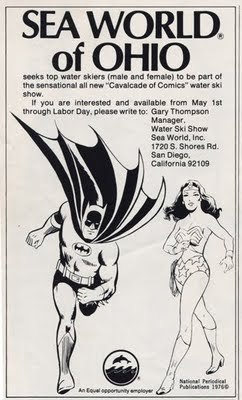 Bill Peterson: Tom Weber said I had to learn back barefoot to be able to get the job. [NOTE: Back barefooting is skiing backwards (facing away from the boat) without skis.] For two weeks I took the hardest falls trying to learn to step off a free board. I would call him on the phone for tips. We would discuss how I was falling and he would coach me over the phone since he was at the Sea World in Ohio. Tom was very patient and helped very much in my getting the job for the superhero show in Orlando. My family and I drove to Ohio to audition but not in costume. I got the job. This was before Sea World Orlando opened.
Bill Peterson: Tom Weber said I had to learn back barefoot to be able to get the job. [NOTE: Back barefooting is skiing backwards (facing away from the boat) without skis.] For two weeks I took the hardest falls trying to learn to step off a free board. I would call him on the phone for tips. We would discuss how I was falling and he would coach me over the phone since he was at the Sea World in Ohio. Tom was very patient and helped very much in my getting the job for the superhero show in Orlando. My family and I drove to Ohio to audition but not in costume. I got the job. This was before Sea World Orlando opened.
Cindy Barhoff (Clasen): At the end of my senior year in high school, I took a group of girls up to our cottage on Lake Chautauqua in New York and taught them how to ski. The next summer, one of them dated Sharkey Schwartz at Sea World. They were short one skier and called me to try out.
Dave Madeline: I watched the show and everything that they were doing on the water I was able to do. I auditioned same day I went there and went to work two days later.
Diane Smith: Since it was necessary to pay back the loan I had taken out in order to attend graduate school, I arrived at the employment office inquiring about a position as a tour guide, but no job was then available. I was aware that Sea World had a water ski show, though I had never seen it. I was told that the ski department might be hiring and that I should fill out an application. I was immediately called in for an audition. Although I had not water skied for many years (I had been in college and then I taught school prior to enrolling and completing graduate school), my audition went well and to my delighted surprise, I was hired.
Doby Buesse: Had an interview with Gary Thompson and Tom Weber. Gary wore a barrister wig. I think they were just clowning around. The wig was a prop from a previous show just laying around the office. This being my first ever job interview, it really broke the ice and made me feel less nervous. I got the job. No audition. Woo-hoo, $3.25 an hour! I was rich!
Jacque Cook (Kuntarich): I was dating a skier. I got up the first time I tried. The 13th time I skied, Sea World called me.
Janalee Zimmerman (Addleman): I went to see the show and decided to apply for a job. I was called by Tommy Weber and made plans to audition. He hired me after that audition. I was thrilled! I was only 18 and was just graduating from Shanksville Stonycreek High School. As a matter of fact, I had to leave high school a week and a half early to begin working in Ohio. I came back for graduation in June of 1977. This was also the year of the Johnstown (PA) Flood.
Jeff Parnell: My mom saw an ad for skiers for Sea World. I showed up with no appointment. I told them what I could do they gave me an audition and I was hired.
Kaci Whittenton (Hedstrum): Via Sharkey Schwartz encouragement.
Kerry Lloyd: Me and Steve Fontaine went to Florida to Cypress Gardens in 1975, snooping around for a job. We talked to Lynn Novakofski and he told us about Gary Thompson. Gary sent us applications and we filled them out and sent them. In May 1976, Fontaine got hired and went to Ohio. Three weeks later they called me because Andy Hansen broke his arm. So I went to Ohio. That was the first year of the superheroes show. I was 20 when I got the job. Saved my life. I was just some young punk kid doing nothing. Next thing I know I'm in a huge production and did that for next 25 years. Everything I've done my whole life's been dangerous.
Mark Gutleben: Sea World built a stadium in Orlando. I left Sea World Ohio. Sea World paid you to move. I lived in a van in a parking lot in Sea World until I had enough money to share rent on a house. I lived with Dave Madeline, Sharkey.
Mary McMurtrie: My cousin Dave Madeline groomed me for the show. We used to summer ski some tournaments together while I was in high school. I was 18 and very naïve when I started and 30 when I finally called it quits. BEST YEARS OF MY LIFE.
Nancy Radant Combes: I applied for the show the summer before working there. I would have just graduated from high school. The day I visited the show it was very busy and there was no time to audition. I was hired based on my amateur experience and because I was the right size. The smaller the better for girls in a ski show.
What was your training/water skiing background before taking the job?
Betsy Maher (Hawkins): Grew up in Florida on a lake. Learned to ski when I was five years old. My first skis had my tennis shoes nailed to them (small feet).
Bill Schwartz: I began skiing at age five in upstate New York. When I was 10 we moved to Candlewood Lake in Connecticut where my older brothers and I meet Pete Knapp [who skied for Cypress Gardens and] who introduced us to advanced skiing tricks like trick skiing, barefooting, and jumping. There also was a water ski show club on Candlewood which we joined. This introduced us to show skiing. Being the youngest in the group, I was the guinea pig and was forced to learn everything they did and more. For example: they took me to the middle of the lake, threw me out of the boat, and told me I either had to learn to barefoot or swim home. Being two miles from home, I learned to barefoot. [In] my teens I became a solid skier with a strong foundation in all areas of water skiing.
Kaci Whittenton (Hedstrum): I did not know how to ski! They taught me how and that was the start of the training program.
Mary McMurtrie: Summer skiing…in other words, not much.
Randy Messer: Most skiers were around college age and came from show ski clubs, which are very popular some Midwestern, Northeastern, and a few Southern states, but Wisconsin is the mecca of show ski clubs. I learned to ski in Iowa on a muddy water lake off the Mississippi.
Suzanne Schwartz: [My husband] Sharkey was an experienced skier, as he grew up spending his summers at Lake Berryessa in Napa County (CA). He was hired as a professional skier at MarineWorld right out of high school. A motorcycle accident in January 1976 shattered his right ankle and ended his professional skiing career, but he continued to be a part of the show as a driver and all-around equipment maintenance guy. I, on the other hand, had no skiing experience whatsoever. I did have dancing experience.
How long was the training for the SWSH show?
Betsy Maher (Hawkins): For me, just a week. During my two-week notice period for leaving the Disney job, I would train during the day and work nights at Disney.
Jeff Parnell: It depended on how good you were—two weeks to a month.
John Gillette: On one hand, I had no training, but jumped right into the show. On the other hand, the training was continuous through the seven years I worked for Sea World.
Steve Fontaine: In Ohio, we started the first of May and it snowed about five inches that first day of practice! We began the show over Memorial Day weekend.
How would you describe the training?
Andy Hansen: I was already trained from previous shows. I just had to train my posture from dancing the Charleston to standing with my hands on my hips while flashing my newly installed "girdle" muscle garment. Because it was a water ski show, training was more fun than anything else. I was at a stage of life where I would go into Sea World on my day off just to hang out and watch the others perform in the show because I loved it so much.
Bill Peterson: Fun and very group-oriented. Always with safety in mind so that the skiers would not get run over [or otherwise hurt]. Such as when you fell, you were to swim a direction to avoid getting run over by the boat as it made its pattern around the show circle. The drivers were incredible.
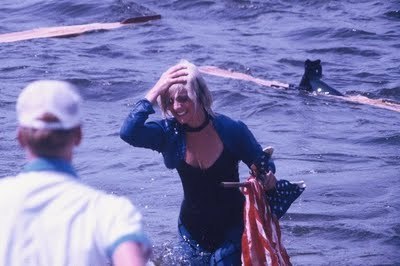 Bill Schwartz: I loved skiing so much that I couldn't get enough. It was tough in the beginning. I was only 125 pounds—skinny kid—and had to learn to pick up girls my own size to do doubles, pyramids, and group acts. When I first got there, the hardest thing for me to learn was to land on the beach with a girl on my skis. I would crash every time. There was only one female skier that would work with me. Her name was Reyna. She stuck it out with me and one day it clicked and I never missed another beach landing ever.
Bill Schwartz: I loved skiing so much that I couldn't get enough. It was tough in the beginning. I was only 125 pounds—skinny kid—and had to learn to pick up girls my own size to do doubles, pyramids, and group acts. When I first got there, the hardest thing for me to learn was to land on the beach with a girl on my skis. I would crash every time. There was only one female skier that would work with me. Her name was Reyna. She stuck it out with me and one day it clicked and I never missed another beach landing ever.
Bubby Snow: We were expected to perform just like the superheroes. We did as much superhero training as water ski training.
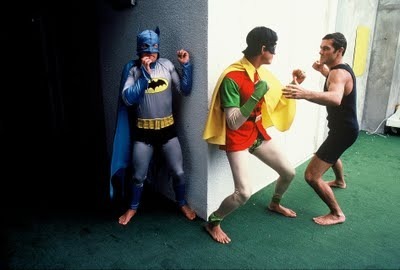 Janalee Zimmerman (Addleman): I remember being very impressed that everything was planned out and timed perfectly, even down to the ropes and how they were wrapped and laid! I remember that I had to learn to slalom ski with my right foot first because the majority of the other girls put their right foot first. I also remember the comedy act—Lois Lane—was difficult for me to learn. I had to jump on Clark Kent as he skied by and I had trouble with the timing. Timing has always been an issue for me! LOL.
Janalee Zimmerman (Addleman): I remember being very impressed that everything was planned out and timed perfectly, even down to the ropes and how they were wrapped and laid! I remember that I had to learn to slalom ski with my right foot first because the majority of the other girls put their right foot first. I also remember the comedy act—Lois Lane—was difficult for me to learn. I had to jump on Clark Kent as he skied by and I had trouble with the timing. Timing has always been an issue for me! LOL.
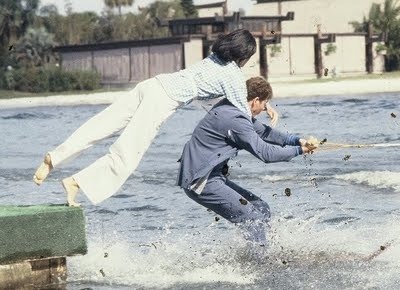
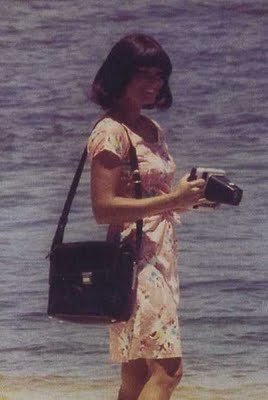
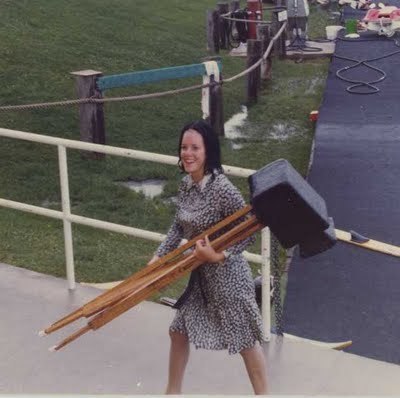 Randy Messer: Started early morning before the first show and the skiers were constantly wet, sore, and cold. The conditions bonded the friendship among these trainees that lasts to this day. One trainee was hired and later became my wife. Back barefoot was one of the premiere ski acts and only a few skiers at that time could end their run with a back to front turn. [One was Mark Gutleben.] We all marveled at Gute. If you asked him how he did it, he couldn't tell you. When he was working something out in his mind, his body would twitch as he mimicked the moves in his head.
Randy Messer: Started early morning before the first show and the skiers were constantly wet, sore, and cold. The conditions bonded the friendship among these trainees that lasts to this day. One trainee was hired and later became my wife. Back barefoot was one of the premiere ski acts and only a few skiers at that time could end their run with a back to front turn. [One was Mark Gutleben.] We all marveled at Gute. If you asked him how he did it, he couldn't tell you. When he was working something out in his mind, his body would twitch as he mimicked the moves in his head.
Sherry Wickstrom: First time I saw them build a pyramid, I was dumbfounded—it was a free-for-all. To build it for the first time, we were on land. When they started to do it, I just stood there. The show director asked me what was wrong. So I explained and I believe Reyna backed me up.
Shirley Duke: It was on-the-job, usually three weeks, 8-9 hours/day. I can't remember if we had weekends off. Intensive, especially for the guys. It wasn't just the skiing; we had beach work, we even had "waving" practice to learn the proper way to wave. We had to memorize songs (I still know the words to the intro song).
[I asked]
OMG—I knew it last week, but when I was trying to write it down, nada. Here's what I got so far:
"We're the heroes that you all adore
We fight bad guys to even the score
Crime and justice is all just the same
We fight bad guys and ruin their game"
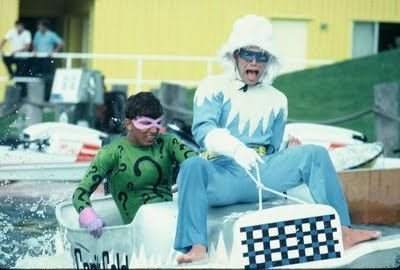 Next: skiers, part 2 of 10.
Next: skiers, part 2 of 10.

Introduction to subseries "Sea World superheroes show" (including list of interviewees).
SWSH = Sea World superheroes
THE TRAINING
How did you get the job with the SWSH show?
Andy Hansen: I was already working at Sea World of Ohio during the previous summers. We did a different themed show the previous year. Sea World changed themes about every two years. The previous show was the "Roaring Twenties Water Frolics." When we went to the superheroes, I was transformed from Charlie Chaplin to Superman overnight. That involved some real superhero kind of power.
Betsy Maher (Hawkins): My cousin Jeff Parnell told me they needed girls who could ski. I was working a summer job at Disney at the time with friends from college.
 Bill Peterson: Tom Weber said I had to learn back barefoot to be able to get the job. [NOTE: Back barefooting is skiing backwards (facing away from the boat) without skis.] For two weeks I took the hardest falls trying to learn to step off a free board. I would call him on the phone for tips. We would discuss how I was falling and he would coach me over the phone since he was at the Sea World in Ohio. Tom was very patient and helped very much in my getting the job for the superhero show in Orlando. My family and I drove to Ohio to audition but not in costume. I got the job. This was before Sea World Orlando opened.
Bill Peterson: Tom Weber said I had to learn back barefoot to be able to get the job. [NOTE: Back barefooting is skiing backwards (facing away from the boat) without skis.] For two weeks I took the hardest falls trying to learn to step off a free board. I would call him on the phone for tips. We would discuss how I was falling and he would coach me over the phone since he was at the Sea World in Ohio. Tom was very patient and helped very much in my getting the job for the superhero show in Orlando. My family and I drove to Ohio to audition but not in costume. I got the job. This was before Sea World Orlando opened.Cindy Barhoff (Clasen): At the end of my senior year in high school, I took a group of girls up to our cottage on Lake Chautauqua in New York and taught them how to ski. The next summer, one of them dated Sharkey Schwartz at Sea World. They were short one skier and called me to try out.
Dave Madeline: I watched the show and everything that they were doing on the water I was able to do. I auditioned same day I went there and went to work two days later.
Diane Smith: Since it was necessary to pay back the loan I had taken out in order to attend graduate school, I arrived at the employment office inquiring about a position as a tour guide, but no job was then available. I was aware that Sea World had a water ski show, though I had never seen it. I was told that the ski department might be hiring and that I should fill out an application. I was immediately called in for an audition. Although I had not water skied for many years (I had been in college and then I taught school prior to enrolling and completing graduate school), my audition went well and to my delighted surprise, I was hired.
Doby Buesse: Had an interview with Gary Thompson and Tom Weber. Gary wore a barrister wig. I think they were just clowning around. The wig was a prop from a previous show just laying around the office. This being my first ever job interview, it really broke the ice and made me feel less nervous. I got the job. No audition. Woo-hoo, $3.25 an hour! I was rich!
Jacque Cook (Kuntarich): I was dating a skier. I got up the first time I tried. The 13th time I skied, Sea World called me.
Janalee Zimmerman (Addleman): I went to see the show and decided to apply for a job. I was called by Tommy Weber and made plans to audition. He hired me after that audition. I was thrilled! I was only 18 and was just graduating from Shanksville Stonycreek High School. As a matter of fact, I had to leave high school a week and a half early to begin working in Ohio. I came back for graduation in June of 1977. This was also the year of the Johnstown (PA) Flood.
Jeff Parnell: My mom saw an ad for skiers for Sea World. I showed up with no appointment. I told them what I could do they gave me an audition and I was hired.
Kaci Whittenton (Hedstrum): Via Sharkey Schwartz encouragement.
Kerry Lloyd: Me and Steve Fontaine went to Florida to Cypress Gardens in 1975, snooping around for a job. We talked to Lynn Novakofski and he told us about Gary Thompson. Gary sent us applications and we filled them out and sent them. In May 1976, Fontaine got hired and went to Ohio. Three weeks later they called me because Andy Hansen broke his arm. So I went to Ohio. That was the first year of the superheroes show. I was 20 when I got the job. Saved my life. I was just some young punk kid doing nothing. Next thing I know I'm in a huge production and did that for next 25 years. Everything I've done my whole life's been dangerous.
Mark Gutleben: Sea World built a stadium in Orlando. I left Sea World Ohio. Sea World paid you to move. I lived in a van in a parking lot in Sea World until I had enough money to share rent on a house. I lived with Dave Madeline, Sharkey.
Mary McMurtrie: My cousin Dave Madeline groomed me for the show. We used to summer ski some tournaments together while I was in high school. I was 18 and very naïve when I started and 30 when I finally called it quits. BEST YEARS OF MY LIFE.
Nancy Radant Combes: I applied for the show the summer before working there. I would have just graduated from high school. The day I visited the show it was very busy and there was no time to audition. I was hired based on my amateur experience and because I was the right size. The smaller the better for girls in a ski show.
What was your training/water skiing background before taking the job?
Betsy Maher (Hawkins): Grew up in Florida on a lake. Learned to ski when I was five years old. My first skis had my tennis shoes nailed to them (small feet).
Bill Schwartz: I began skiing at age five in upstate New York. When I was 10 we moved to Candlewood Lake in Connecticut where my older brothers and I meet Pete Knapp [who skied for Cypress Gardens and] who introduced us to advanced skiing tricks like trick skiing, barefooting, and jumping. There also was a water ski show club on Candlewood which we joined. This introduced us to show skiing. Being the youngest in the group, I was the guinea pig and was forced to learn everything they did and more. For example: they took me to the middle of the lake, threw me out of the boat, and told me I either had to learn to barefoot or swim home. Being two miles from home, I learned to barefoot. [In] my teens I became a solid skier with a strong foundation in all areas of water skiing.
Kaci Whittenton (Hedstrum): I did not know how to ski! They taught me how and that was the start of the training program.
Mary McMurtrie: Summer skiing…in other words, not much.
Randy Messer: Most skiers were around college age and came from show ski clubs, which are very popular some Midwestern, Northeastern, and a few Southern states, but Wisconsin is the mecca of show ski clubs. I learned to ski in Iowa on a muddy water lake off the Mississippi.
Suzanne Schwartz: [My husband] Sharkey was an experienced skier, as he grew up spending his summers at Lake Berryessa in Napa County (CA). He was hired as a professional skier at MarineWorld right out of high school. A motorcycle accident in January 1976 shattered his right ankle and ended his professional skiing career, but he continued to be a part of the show as a driver and all-around equipment maintenance guy. I, on the other hand, had no skiing experience whatsoever. I did have dancing experience.
How long was the training for the SWSH show?
Betsy Maher (Hawkins): For me, just a week. During my two-week notice period for leaving the Disney job, I would train during the day and work nights at Disney.
Jeff Parnell: It depended on how good you were—two weeks to a month.
John Gillette: On one hand, I had no training, but jumped right into the show. On the other hand, the training was continuous through the seven years I worked for Sea World.
Steve Fontaine: In Ohio, we started the first of May and it snowed about five inches that first day of practice! We began the show over Memorial Day weekend.
How would you describe the training?
Andy Hansen: I was already trained from previous shows. I just had to train my posture from dancing the Charleston to standing with my hands on my hips while flashing my newly installed "girdle" muscle garment. Because it was a water ski show, training was more fun than anything else. I was at a stage of life where I would go into Sea World on my day off just to hang out and watch the others perform in the show because I loved it so much.
Bill Peterson: Fun and very group-oriented. Always with safety in mind so that the skiers would not get run over [or otherwise hurt]. Such as when you fell, you were to swim a direction to avoid getting run over by the boat as it made its pattern around the show circle. The drivers were incredible.
 Bill Schwartz: I loved skiing so much that I couldn't get enough. It was tough in the beginning. I was only 125 pounds—skinny kid—and had to learn to pick up girls my own size to do doubles, pyramids, and group acts. When I first got there, the hardest thing for me to learn was to land on the beach with a girl on my skis. I would crash every time. There was only one female skier that would work with me. Her name was Reyna. She stuck it out with me and one day it clicked and I never missed another beach landing ever.
Bill Schwartz: I loved skiing so much that I couldn't get enough. It was tough in the beginning. I was only 125 pounds—skinny kid—and had to learn to pick up girls my own size to do doubles, pyramids, and group acts. When I first got there, the hardest thing for me to learn was to land on the beach with a girl on my skis. I would crash every time. There was only one female skier that would work with me. Her name was Reyna. She stuck it out with me and one day it clicked and I never missed another beach landing ever. Bubby Snow: We were expected to perform just like the superheroes. We did as much superhero training as water ski training.
 Janalee Zimmerman (Addleman): I remember being very impressed that everything was planned out and timed perfectly, even down to the ropes and how they were wrapped and laid! I remember that I had to learn to slalom ski with my right foot first because the majority of the other girls put their right foot first. I also remember the comedy act—Lois Lane—was difficult for me to learn. I had to jump on Clark Kent as he skied by and I had trouble with the timing. Timing has always been an issue for me! LOL.
Janalee Zimmerman (Addleman): I remember being very impressed that everything was planned out and timed perfectly, even down to the ropes and how they were wrapped and laid! I remember that I had to learn to slalom ski with my right foot first because the majority of the other girls put their right foot first. I also remember the comedy act—Lois Lane—was difficult for me to learn. I had to jump on Clark Kent as he skied by and I had trouble with the timing. Timing has always been an issue for me! LOL.

 Randy Messer: Started early morning before the first show and the skiers were constantly wet, sore, and cold. The conditions bonded the friendship among these trainees that lasts to this day. One trainee was hired and later became my wife. Back barefoot was one of the premiere ski acts and only a few skiers at that time could end their run with a back to front turn. [One was Mark Gutleben.] We all marveled at Gute. If you asked him how he did it, he couldn't tell you. When he was working something out in his mind, his body would twitch as he mimicked the moves in his head.
Randy Messer: Started early morning before the first show and the skiers were constantly wet, sore, and cold. The conditions bonded the friendship among these trainees that lasts to this day. One trainee was hired and later became my wife. Back barefoot was one of the premiere ski acts and only a few skiers at that time could end their run with a back to front turn. [One was Mark Gutleben.] We all marveled at Gute. If you asked him how he did it, he couldn't tell you. When he was working something out in his mind, his body would twitch as he mimicked the moves in his head.Sherry Wickstrom: First time I saw them build a pyramid, I was dumbfounded—it was a free-for-all. To build it for the first time, we were on land. When they started to do it, I just stood there. The show director asked me what was wrong. So I explained and I believe Reyna backed me up.
Shirley Duke: It was on-the-job, usually three weeks, 8-9 hours/day. I can't remember if we had weekends off. Intensive, especially for the guys. It wasn't just the skiing; we had beach work, we even had "waving" practice to learn the proper way to wave. We had to memorize songs (I still know the words to the intro song).
[I asked]
OMG—I knew it last week, but when I was trying to write it down, nada. Here's what I got so far:
"We're the heroes that you all adore
We fight bad guys to even the score
Crime and justice is all just the same
We fight bad guys and ruin their game"
 Next: skiers, part 2 of 10.
Next: skiers, part 2 of 10.
Published on September 01, 2011 04:22
August 31, 2011
Super '70s and '80s: Sea World superheroes water ski show—Dan Poor, high diver (Green Arrow)
Introduction to series "Super '70s and '80s."
Introduction to subseries "Sea World superheroes show" (including list of interviewees).
SWSH = Sea World superheroes
How did you get the job with the SWSH show?
I auditioned at the Dade County Youth Fair for Maxwell Associates at one of their high dive tank shows (26' diameter and 9½' deep). A good friend of mine was going to defend his title as Acapulco Cliff Diving Champion and he gave me an opportunity to fill in for him at the fair in Miami. The producer of the show, Norma Maxwell, liked how I dove and thought I'd fit in well at Sea World where she had a contract to provide high divers to the ski show. At the time they were at the end of a two year run of doing the superheroes show. I got there in April, just in time to learn the Green Arrow part before we redid the show [to a] new [non-superhero] show called "Almost Anything Goes."
What was your training/water skiing background before taking the job?
I was a gymnast in high school and on the diving team at Rutgers University.
How long was the training for the SWSH show?
My part was pretty simple so it only took a day. I already knew how to high dive from 80'!
How would you describe the training?
I learned how to be a showman and play to the crowd with large gestures.
How did you feel dressing like a superhero?
Loved it. It was the biggest stadium I'd ever performed in up until that time. The superhero costume allowed me to express my alter ego.
What exactly did you do in the show?
Triple somersault from 80' into a flaming pool of water.
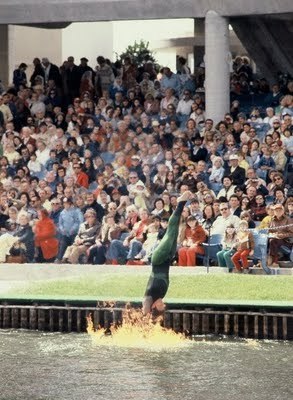 What, if any, mistakes or accidents happened during a show?
What, if any, mistakes or accidents happened during a show?
If there was no wind, I'd be in the flames longer and sometimes my eyelashes and eyebrows would get singed.
How much time did your group of SWSH performers spend together both professionally and personally?
Putting our lives on the line every day brought us together. We ate together, huddled together when it got cold, rained, or lightning threatened us. We shared apartments, lifted weights, trained, partied, dated, and generally looked out for each other. Nineteen seventy-nine was my first summer away from home and it was one of the most memorable summers of my life. I felt so blessed to be getting paid to do something I loved. I fell in love that summer, too, and we're still friends to this day.
How many SWSH performers have you been in touch with continuously since the show ended?
Only a few, but via Facebook I've reconnected with at least 18 of the SWSH performers and probably another 60+ who performed at the same theater after SWSH ended.
Did you feel like celebrities at the time? If so, only at Sea World or also around town? Were you ever recognized on the street or in line at the store?
Are you kidding?
If a comic book/pop culture convention paid your way, would you attend and sign autographs for fans?
Yes!
Did you portray any other characters besides superheroes at Sea World or elsewhere?
Recently I performed as Spider-Man, in Cirque Du Chimelong, in Guangzhou, China, although they didn't refer to my character as Spider-Man. The Chinese are famous for imitations, as you know! I dropped into the stadium from an 80' perch in the ceiling, upside down, then did a flip into a flaming moat that surrounded the stage. I then disappeared under water, swimming the length of the moat under water until I was behind stage.
Have you had anything to do with superheroes since (read comics, see superhero movies, superhero Halloween costumes)?
I've seen most of the blockbusters.
What do you do for a living?
Health and fitness consultant, personal trainer, strength & conditioning coach, and high diver! I graduated from UCF in Orlando, married, had two children, and had my own business until 1994.
Where do you live?
Portland, OR.
How old are your children?
I have two children who live in Florida. Danny is 18 and Tori is 20. Tori's married and gave birth to my first grandson, Lux, [in 2009].
Do your children water ski/perform?
My daughter was an Olympic-bound gymnast for ten years until injury derailed her in 2003.
Do you think you guys could get back in the water and do any of it again now?
I sure could! Name the place!
How do you look back at your time with SWSH show?
One of the most exciting times of my life. Fortunate to have participated for the short time I did.
Do you have a favorite memory about the SWSH show?
Meeting Sarah Christina Ashley in the hall. I caught her checking me out the first day, and I was smitten. She played Catwoman and Wonder Woman and looked really hot in her costumes!
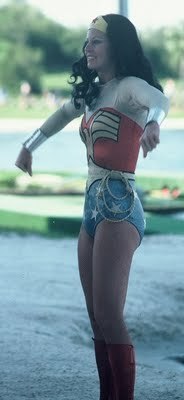 Next: the skiers (almost 40 of them!), part 1 of 10.
Next: the skiers (almost 40 of them!), part 1 of 10.

Introduction to subseries "Sea World superheroes show" (including list of interviewees).
SWSH = Sea World superheroes
How did you get the job with the SWSH show?
I auditioned at the Dade County Youth Fair for Maxwell Associates at one of their high dive tank shows (26' diameter and 9½' deep). A good friend of mine was going to defend his title as Acapulco Cliff Diving Champion and he gave me an opportunity to fill in for him at the fair in Miami. The producer of the show, Norma Maxwell, liked how I dove and thought I'd fit in well at Sea World where she had a contract to provide high divers to the ski show. At the time they were at the end of a two year run of doing the superheroes show. I got there in April, just in time to learn the Green Arrow part before we redid the show [to a] new [non-superhero] show called "Almost Anything Goes."
What was your training/water skiing background before taking the job?
I was a gymnast in high school and on the diving team at Rutgers University.
How long was the training for the SWSH show?
My part was pretty simple so it only took a day. I already knew how to high dive from 80'!
How would you describe the training?
I learned how to be a showman and play to the crowd with large gestures.
How did you feel dressing like a superhero?
Loved it. It was the biggest stadium I'd ever performed in up until that time. The superhero costume allowed me to express my alter ego.
What exactly did you do in the show?
Triple somersault from 80' into a flaming pool of water.
 What, if any, mistakes or accidents happened during a show?
What, if any, mistakes or accidents happened during a show?If there was no wind, I'd be in the flames longer and sometimes my eyelashes and eyebrows would get singed.
How much time did your group of SWSH performers spend together both professionally and personally?
Putting our lives on the line every day brought us together. We ate together, huddled together when it got cold, rained, or lightning threatened us. We shared apartments, lifted weights, trained, partied, dated, and generally looked out for each other. Nineteen seventy-nine was my first summer away from home and it was one of the most memorable summers of my life. I felt so blessed to be getting paid to do something I loved. I fell in love that summer, too, and we're still friends to this day.
How many SWSH performers have you been in touch with continuously since the show ended?
Only a few, but via Facebook I've reconnected with at least 18 of the SWSH performers and probably another 60+ who performed at the same theater after SWSH ended.
Did you feel like celebrities at the time? If so, only at Sea World or also around town? Were you ever recognized on the street or in line at the store?
Are you kidding?
If a comic book/pop culture convention paid your way, would you attend and sign autographs for fans?
Yes!
Did you portray any other characters besides superheroes at Sea World or elsewhere?
Recently I performed as Spider-Man, in Cirque Du Chimelong, in Guangzhou, China, although they didn't refer to my character as Spider-Man. The Chinese are famous for imitations, as you know! I dropped into the stadium from an 80' perch in the ceiling, upside down, then did a flip into a flaming moat that surrounded the stage. I then disappeared under water, swimming the length of the moat under water until I was behind stage.
Have you had anything to do with superheroes since (read comics, see superhero movies, superhero Halloween costumes)?
I've seen most of the blockbusters.
What do you do for a living?
Health and fitness consultant, personal trainer, strength & conditioning coach, and high diver! I graduated from UCF in Orlando, married, had two children, and had my own business until 1994.
Where do you live?
Portland, OR.
How old are your children?
I have two children who live in Florida. Danny is 18 and Tori is 20. Tori's married and gave birth to my first grandson, Lux, [in 2009].
Do your children water ski/perform?
My daughter was an Olympic-bound gymnast for ten years until injury derailed her in 2003.
Do you think you guys could get back in the water and do any of it again now?
I sure could! Name the place!
How do you look back at your time with SWSH show?
One of the most exciting times of my life. Fortunate to have participated for the short time I did.
Do you have a favorite memory about the SWSH show?
Meeting Sarah Christina Ashley in the hall. I caught her checking me out the first day, and I was smitten. She played Catwoman and Wonder Woman and looked really hot in her costumes!
 Next: the skiers (almost 40 of them!), part 1 of 10.
Next: the skiers (almost 40 of them!), part 1 of 10.
Published on August 31, 2011 04:11
August 30, 2011
Super '70s and '80s: Sea World superheroes water ski show—Curt Rector and Ken McCabe, announcers
Introduction to series "Super '70s and '80s."
Introduction to subseries "Sea World superheroes show" (including list of interviewees).
SWSH = Sea World superheroes
[NOTE: I did not interview them at the same time; I combined their answers since they had the same job.]
How did you get the job with the SWSH show?
Curt: I had been performing in local dinner theater and when the audition was announced for the Sea World position I went to the general call. I was called back once I think and then ultimately was told that because I didn't have a degree in Theater Arts, a prerequisite they'd asked for, I had come in second to another young man, Eric Cornfeld, who had the degree. At the time I thought, "Well, they're just being nice and blowing a little smoke to make me feel better." I was woefully ignorant of the entertainment business and didn't realize how unusual it was for them to have told me such a thing. I continued working at the theater and when not cast in the next show, I went to work in the theater, first as a busboy and then got taken into the kitchen as assistant chef.
A year later Sea World called to say that Eric had developed nodules on his vocal cords and was going to have to leave the show. I re-auditioned and was immediately offered the job. My employer at the theater was kind enough to order me to leave his employ and take the job at Sea World.
Ken: I had announced the ski show at the end of the season the year prior.
How old were you when you started with the SWSH show?
Curt: I was 21 and married with a child on the way.
Ken: Started at 22.
What was your background before taking the job?
Curt: I was raised in a military family. My father retired from the military and took a position as head bodyguard and chief of security for a big company in Orlando, FL. I followed him into the security profession and worked as a security guard, then as a commanding officer in the company I worked for and ultimately as an undercover investigator for the same company. I left that security company after seeing a play and then attending a workshop course offered by the theater—incidentally the same theater that I cooked for later.
Ken: I was a theater major and a comic collector although the latter wasn't a prerequisite.
Which characters did you portray?
Curt: I played Jimmy Olsen (host) and the Joker (comedy relief), and on one notable occasion, the Riddler.
Ken: I alternately played the host, Jimmy Olsen, and the Joker.
Was there one that you preferred? If so, why?
Curt: Jimmy Olsen was a much more challenging role, technically, because in essence the entire show cued off your monologue. Olsen was responsible for controlling the audience reactions, making sure that the audience was looking the right way at the right time, managing the timing of the show through pace, ad-libbing in the event of a fall by one (or more) of the skiers, even to the extent of reassuring the audience as to the health of the fallen skier, not to mention being the "seller" of the show.
The Joker, on the other hand, was a blast to play. Olsen was a role that was locked in—ad-libbing was not possible. But the Joker was an ad-libber's dream. We would often improv and generally indulge ourselves in all sorts of shenanigans. We would play jokes on each other from time to time, also on the skiers we worked with; it was a dream role. Lots of fun and all about making the audience laugh and taking up time; the Joker's gags were used to allow time for the water to calm between ski acts.
I always regarded Olsen as "the job" and the Joker as "the reward for doing the job."
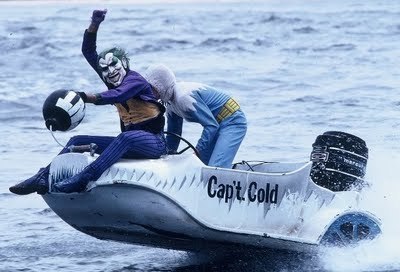 Ken: I liked the host role because it was my own face in front of the crowd but the Joker was easier (shorter in the summer heat).
Ken: I liked the host role because it was my own face in front of the crowd but the Joker was easier (shorter in the summer heat).
Did you portray any characters that you hadn't heard of before?
Curt: Not in the ski show. I was well-versed in superheroes and their lore. At the time I went to work at Sea World I could have easily told you that Green Lantern was really Hal Jordan, test-pilot, that his ring was provided by the Guardians of Oa, little greenish-blue guys with big heads. Clark Kent's real name was Kal-El, his father Jor-El, and so on and so on. [Somehow] I retained all of that knowledge from reading comic books in my misspent youth. I even knew that Aquaman's wife was named Mera.
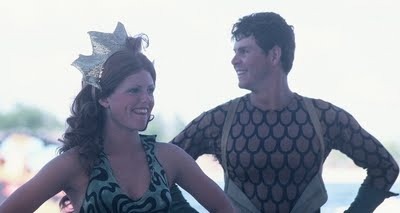 How did you feel dressing like a superhero?
How did you feel dressing like a superhero?
Ken: Never did. [Except] I once took someone's place at a PR appearance as Batman. For some reason, they forgot to bring my cape so I made up a story about how it had gotten really wrinkled in a fight and Alfred wouldn't let me go to a public appearance with an unkempt cape.
What was the show's story?
Curt: The storyline was pretty straightforward: "The First Annual Gotham-Metropolis Water Games." The superheroes were "competing" and the super villains—the Joker, the Riddler, and the Penguin—were trying to break up the show by kidnapping Batgirl and later Robin and putting them in peril, from which they performed magical escapes. In later iterations of the show, several of the super villains actually performed a competing ski act called "The Triple Jump-Out" in which they would leap out of their skis and barefoot away, the last villain still upright being declared the winner.
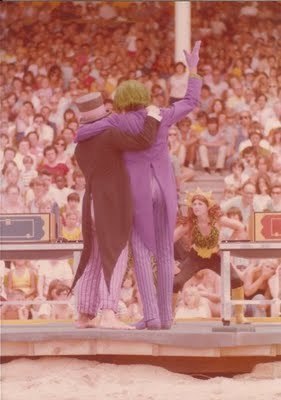 Ken: It was more of an event than a story—the first Gotham-Metropolis Water Games. A friendly contest of skills performed by the superheroes. Of course it was always being broken up by the super villains (Joker, Penguin, Riddler, Captain Cold). Of those, only the Joker had a live microphone and performed magic illusions that always gave the appearance of disposing the heroes in some way.
Ken: It was more of an event than a story—the first Gotham-Metropolis Water Games. A friendly contest of skills performed by the superheroes. Of course it was always being broken up by the super villains (Joker, Penguin, Riddler, Captain Cold). Of those, only the Joker had a live microphone and performed magic illusions that always gave the appearance of disposing the heroes in some way.
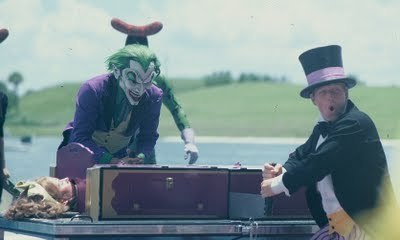 Part of the show took place on a stage and a beach. If you had lines during those portions, how did the audience hear you?
Part of the show took place on a stage and a beach. If you had lines during those portions, how did the audience hear you?
Ken: Only Olsen and the Joker had microphones. The others were lip syncing recorded dialogue: "Nice try, double dopes, but your act is over!"
Did the characters have different personalities, or were they all simply "good," as was common in superhero cartoons of the period?
Ken: Oh come on. Good guys were good and bad guys were bad. Only the Joker developed into a character with a little more depth. As he performed his magic acts, he would tell awful jokes to punctuate the trick. When sawing Batgirl in half, he would say "It's just a slice of life! Get it? A slice of life! A slice…. aw, never mind!" He became this character who enjoyed telling the jokes more than what he was doing with the heroes. This pathetic vaudeville comedian with terrible material. It was fun.
What, if any, mistakes or accidents happened during a show?
Ken: I remember announcing the show in Ohio when Batman took the little kid for a ride in the Batboat and ran out of gas. I said that he was towed in with the Batrope. Another time an announcer named David Huang was playing the Joker and during the fight scene, his mask flew completely off his head. [Who knew] the Joker is Asian!
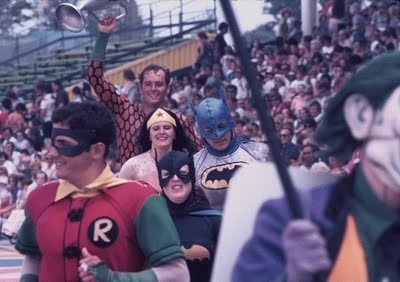 Which celebrities attended a show?
Which celebrities attended a show?
Curt: The Atlantis Stadium was also a concert performance venue. Wayne Newton, Crystal Gayle, Seals & Croft, and various other performers watched the show. I believe either Rosalyn Carter or some other First Lady watched the show. I did a night show with Joe Garagiola. Along the way I stepped on Crystal Gayle's toes in the hall, beat on the then-governor of Florida's kidneys with the butt of my microphone, and demanded—and got—an apology from Wayne Newton when his "people" stole my bathrobe and then he fell into the mud while wearing it.
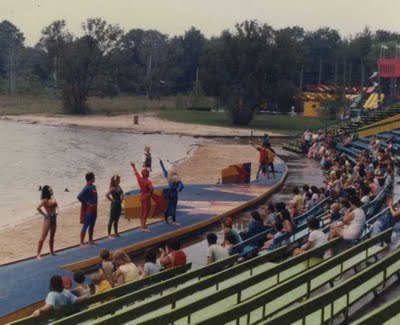 Any funny/unusual show anecdotes that you didn't address already?
Any funny/unusual show anecdotes that you didn't address already?
Curt: Which would you like to hear about? The time I broke my ankle jumping over the curb with Robin in my arms, the time a little girl came out of the audience and punched the Joker in the boy parts during an act (gasps of pain not only from the Joker but every man in the audience), the woman who hiked up her skirt and squatted down to get a picture of me (as Olsen) with the superheroes in pyramid in the background and forgot she wasn't wearing any underwear, the time the emus who lived on a hillside near our stadium escaped during a show and ran amok while being chased by their handlers, the lies we told the skiers about the otters escaping from their stadium and infesting the lake, or one of the other myriad stories from those halcyon days?
Ken: In Ohio, they wanted Sunja, the world's only water skiing elephant, in the show, so they decided that Tarzan was close enough to superhero to include him. One night during the last show, I had to run around the back of the stadium to make an entrance on the other end of the beach and that was the only way. It was kind of late so no guests were back there as I ran to make my cue. Suddenly, who do I see coming around the corner heading my way? None other than Sunja. So I figure I have to stop this elephant before he runs into any guests.
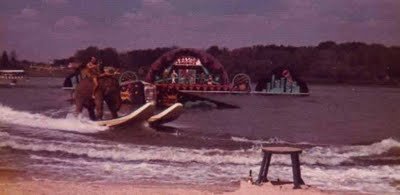 You have not been drinking. That is a water skiing elephant.
You have not been drinking. That is a water skiing elephant.
I bravely move toward him trying to persuade him to go back towards his pen when he lifts on leg up and gently puts it onto one of the nearby restaurants tables. With a creaking sound, I watch as the table is bent down to the ground like you might crush a paper cup. That was plenty for me. I took off running in the other direction and was going to make my cue from the other side of the beach.
As I round the corner to the stage at the center of the beach, here comes Sunja from the other side. She is now walking slowly into the stands. Luckily it was a small crowd and they were sitting up much higher. The ski show manager, Gary Thompson, was playing Captain Marvel that night and he ran across the beach and grabbed Sunja by the ear and led her off the beach and back to her cage. I'll never forget the sight of Captain Marvel coming to the rescue, saving us all from the rampaging elephant.
What was your salary/compensation for performing in the SWSH show?
Ken: My first summer I made $1,000/month. I went up from there.
How much behind-the-scenes romance was there among skiers?
Curt: Quite a lot, I think. Susie and Sharkey Schwartz were always an item and are a long-married couple now, as are Gary Thompson and his wife Connie [skier Jacque Cook: "She looked like Suzanne Somers. A beautiful girl"], who was a skier in the show. I didn't really keep track because I didn't really want to know, but you can't have that many extremely healthy young people wandering around in very little clothing (bathing suits), practicing lifts, etc. without a certain amount of grab-ass taking place and ultimately leading to romances behind the scenes.
Ken: I met my first wife at Sea World.
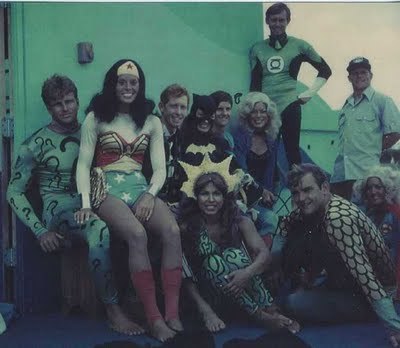 Did you feel like celebrities at the time?
Did you feel like celebrities at the time?
Curt: Not remotely. For a brief period we did personal appearances at the stadium after the show. No one gave a rip for Jimmy Olsen, and the reaction of children in particular to the Joker seemed to depend entirely on the performer behind the mask. Children would talk to me, but never touch me. They'd stay so far away from Ken as the Joker that they could hardly be said to be communicating at all. [Fellow announcer] Dick Monday, on the other hand, they climbed all over.
Can you share any funny/creepy/flattering fan stories? Did you get any fan letters?
Ken: No, although there were some weird summer pass holders in Ohio that kept scrapbooks of photos of all the performers in the show. They came almost every other day.
If a comic book/pop culture convention paid your way, would you attend and sign autographs for fans?
Ken: I don't think they would want me.
Have you had anything to do with superheroes since (read comics, see superhero movies, superhero Halloween costumes)?
Ken: I collected Silver Age comics for a long time but unfortunately had to sell my collection at one time years back. I regret doing so.
Where do you live now?
Curt: Winter Park, FL.
Ken: Still in Orlando, FL.
What do you do for a living?
Curt: I'm a video technician. I do conferences and conventions all over the country.
Ken: I am now the corporate entertainment director for Dolly Parton's Dixie Stampede.
If you have children, how old are they?
Curt: I have a daughter who is 33.
Ken: 28 and 26.
What do they think of your time in a superhero show?
Ken: They were too young when we had that show. But they are both into comics as well.
Do you have a favorite memory about the SWSH show?
Curt: One of my clearest memories is of the first time that I performed the Olsen role. I had been in rehearsal only for about two weeks or a bit more. Generally Olsen took about four or more weeks to fully rehearse before a first performance. However, I was already doing the Joker and Dick Monday and Ken McCabe had been without a vacation for quite some time, so Ken took a vacation while Dick and I continued doing shows two times a day, seven days a week. During Ken's absence Dick was involved in a bad car accident which hospitalized him. We found out about his accident some three hours before show time when the hospital called the announcer office and told me Mr. Monday had been hurt and was under anesthetic. The hospital staff was forcibly restraining him to prevent him from getting up and leaving the hospital.
A hectic conference call ensued between me, the head of entertainment, the head of our staff, Chuck Jordan, and a VP of the park or something like that. The big question was would we do the show or not. I finally said that I knew the script and that I could get through it. Chuck felt he could bulldoze his way through the Joker magic, so we went for it.
As I was waiting in the tunnel for my first entrance as Jimmy Olsen I could hear an incredible amount of noise in the stadium, which held a max audience of 4,500. I called over an ops guy and asked what the hell all the noise was about. He said, and I quote, "Damn, man, this is the biggest audience I've ever seen for a ski show!" The audience had spilled out of the stadium and were sitting all over the berms on either side of the stadium. We later estimated the audience at around 9,000—double capacity. When my intro music played and I ran out onto the stage and turned to face the audience, they spread across a full 180% of my sight-line. I stood there staring at them dumbfounded. I remember looking up into the sound booth and seeing the sound op's eyes getting bigger and bigger as I stood there without speaking. I took a deep breath and…
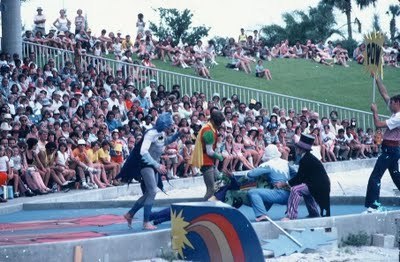 "Good afternoon, ladies and gentlemen, and welcome to the first annual Gotham-Metropolis Water Games! My name is Jimmy Olsen and I'll be your host and commentator. And now (dramatic pause) let's meet the superheroes!" Music swell, grand sweeping gesture to water as superheroes in formation ski into sight from behind the set. And we were off.
"Good afternoon, ladies and gentlemen, and welcome to the first annual Gotham-Metropolis Water Games! My name is Jimmy Olsen and I'll be your host and commentator. And now (dramatic pause) let's meet the superheroes!" Music swell, grand sweeping gesture to water as superheroes in formation ski into sight from behind the set. And we were off.
It was a breathtaking moment for me. Later I watched as Chuck performed as the Joker. I was the largest of the announcers but Chuck made me look tiny; nevertheless my Joker costume came closest to fitting him, which is to say, not at all. I remember thinking, "Well, that'll never fit right again." But we got through the show and although Dick returned to us within a day or two, he still couldn't perform so Chuck and I did the show for another four or five days until Ken came back. So I have the distinction of being the only announcer to have performed in a show with Chuck as the Joker.
What other memorabilia, if any, did you save from the SWSH show (posters, programs/souvenir booklets, etc.)?
Curt: For quite some time I had the last Joker mask. It was made from Ken's original mold but over the year and a half that we were making them we'd added some modifications, like embedding base colors in the latex, etc. It [began to smell and] finally rotted and collapsed to the point that it looked like a mummy's head and I got rid of it.
Do you still have the script?
Curt: Somewhere in a box I probably still have one. I ran across a couple different Sea World scripts in a box while cleaning the garage last year but I'm not sure what I did with them.
What was your reaction when you first heard why I was contacting you?
Curt: Bemusement. I can't imagine why anyone would care about the superhero show except for those of us who were involved. It wasn't exactly a pandemic phenomenon. [But] it was an interesting time and a show that seemed to entertain a lot of people and I was sad to see it go.
How do you look back at your time with the SWSH show?
Curt: With great fondness. As I say, it was the greatest summer job I ever had [and it] lasted 2.5 years. It's also where I met my beloved. It's where I was working when my first wife and I divorced. It's where I became close to my best friends in the world. Were it not for circumstantial issues I might well have pursued a much longer career at Sea World.
I learned a great deal about performing and appeared live before over 6.5 million people during my time there. Since then I've never encountered a crowd of people before whom I had to speak that unnerved me. My career as an actor blossomed from that point and I appeared in several independent movies and a large number of plays post-Sea World.
Next: Dan Poor, high diver (Green Arrow).
Introduction to subseries "Sea World superheroes show" (including list of interviewees).
SWSH = Sea World superheroes
[NOTE: I did not interview them at the same time; I combined their answers since they had the same job.]
How did you get the job with the SWSH show?
Curt: I had been performing in local dinner theater and when the audition was announced for the Sea World position I went to the general call. I was called back once I think and then ultimately was told that because I didn't have a degree in Theater Arts, a prerequisite they'd asked for, I had come in second to another young man, Eric Cornfeld, who had the degree. At the time I thought, "Well, they're just being nice and blowing a little smoke to make me feel better." I was woefully ignorant of the entertainment business and didn't realize how unusual it was for them to have told me such a thing. I continued working at the theater and when not cast in the next show, I went to work in the theater, first as a busboy and then got taken into the kitchen as assistant chef.
A year later Sea World called to say that Eric had developed nodules on his vocal cords and was going to have to leave the show. I re-auditioned and was immediately offered the job. My employer at the theater was kind enough to order me to leave his employ and take the job at Sea World.
Ken: I had announced the ski show at the end of the season the year prior.
How old were you when you started with the SWSH show?
Curt: I was 21 and married with a child on the way.
Ken: Started at 22.
What was your background before taking the job?
Curt: I was raised in a military family. My father retired from the military and took a position as head bodyguard and chief of security for a big company in Orlando, FL. I followed him into the security profession and worked as a security guard, then as a commanding officer in the company I worked for and ultimately as an undercover investigator for the same company. I left that security company after seeing a play and then attending a workshop course offered by the theater—incidentally the same theater that I cooked for later.
Ken: I was a theater major and a comic collector although the latter wasn't a prerequisite.
Which characters did you portray?
Curt: I played Jimmy Olsen (host) and the Joker (comedy relief), and on one notable occasion, the Riddler.
Ken: I alternately played the host, Jimmy Olsen, and the Joker.
Was there one that you preferred? If so, why?
Curt: Jimmy Olsen was a much more challenging role, technically, because in essence the entire show cued off your monologue. Olsen was responsible for controlling the audience reactions, making sure that the audience was looking the right way at the right time, managing the timing of the show through pace, ad-libbing in the event of a fall by one (or more) of the skiers, even to the extent of reassuring the audience as to the health of the fallen skier, not to mention being the "seller" of the show.
The Joker, on the other hand, was a blast to play. Olsen was a role that was locked in—ad-libbing was not possible. But the Joker was an ad-libber's dream. We would often improv and generally indulge ourselves in all sorts of shenanigans. We would play jokes on each other from time to time, also on the skiers we worked with; it was a dream role. Lots of fun and all about making the audience laugh and taking up time; the Joker's gags were used to allow time for the water to calm between ski acts.
I always regarded Olsen as "the job" and the Joker as "the reward for doing the job."
 Ken: I liked the host role because it was my own face in front of the crowd but the Joker was easier (shorter in the summer heat).
Ken: I liked the host role because it was my own face in front of the crowd but the Joker was easier (shorter in the summer heat).Did you portray any characters that you hadn't heard of before?
Curt: Not in the ski show. I was well-versed in superheroes and their lore. At the time I went to work at Sea World I could have easily told you that Green Lantern was really Hal Jordan, test-pilot, that his ring was provided by the Guardians of Oa, little greenish-blue guys with big heads. Clark Kent's real name was Kal-El, his father Jor-El, and so on and so on. [Somehow] I retained all of that knowledge from reading comic books in my misspent youth. I even knew that Aquaman's wife was named Mera.
 How did you feel dressing like a superhero?
How did you feel dressing like a superhero?Ken: Never did. [Except] I once took someone's place at a PR appearance as Batman. For some reason, they forgot to bring my cape so I made up a story about how it had gotten really wrinkled in a fight and Alfred wouldn't let me go to a public appearance with an unkempt cape.
What was the show's story?
Curt: The storyline was pretty straightforward: "The First Annual Gotham-Metropolis Water Games." The superheroes were "competing" and the super villains—the Joker, the Riddler, and the Penguin—were trying to break up the show by kidnapping Batgirl and later Robin and putting them in peril, from which they performed magical escapes. In later iterations of the show, several of the super villains actually performed a competing ski act called "The Triple Jump-Out" in which they would leap out of their skis and barefoot away, the last villain still upright being declared the winner.
 Ken: It was more of an event than a story—the first Gotham-Metropolis Water Games. A friendly contest of skills performed by the superheroes. Of course it was always being broken up by the super villains (Joker, Penguin, Riddler, Captain Cold). Of those, only the Joker had a live microphone and performed magic illusions that always gave the appearance of disposing the heroes in some way.
Ken: It was more of an event than a story—the first Gotham-Metropolis Water Games. A friendly contest of skills performed by the superheroes. Of course it was always being broken up by the super villains (Joker, Penguin, Riddler, Captain Cold). Of those, only the Joker had a live microphone and performed magic illusions that always gave the appearance of disposing the heroes in some way. Part of the show took place on a stage and a beach. If you had lines during those portions, how did the audience hear you?
Part of the show took place on a stage and a beach. If you had lines during those portions, how did the audience hear you?Ken: Only Olsen and the Joker had microphones. The others were lip syncing recorded dialogue: "Nice try, double dopes, but your act is over!"
Did the characters have different personalities, or were they all simply "good," as was common in superhero cartoons of the period?
Ken: Oh come on. Good guys were good and bad guys were bad. Only the Joker developed into a character with a little more depth. As he performed his magic acts, he would tell awful jokes to punctuate the trick. When sawing Batgirl in half, he would say "It's just a slice of life! Get it? A slice of life! A slice…. aw, never mind!" He became this character who enjoyed telling the jokes more than what he was doing with the heroes. This pathetic vaudeville comedian with terrible material. It was fun.
What, if any, mistakes or accidents happened during a show?
Ken: I remember announcing the show in Ohio when Batman took the little kid for a ride in the Batboat and ran out of gas. I said that he was towed in with the Batrope. Another time an announcer named David Huang was playing the Joker and during the fight scene, his mask flew completely off his head. [Who knew] the Joker is Asian!
 Which celebrities attended a show?
Which celebrities attended a show?Curt: The Atlantis Stadium was also a concert performance venue. Wayne Newton, Crystal Gayle, Seals & Croft, and various other performers watched the show. I believe either Rosalyn Carter or some other First Lady watched the show. I did a night show with Joe Garagiola. Along the way I stepped on Crystal Gayle's toes in the hall, beat on the then-governor of Florida's kidneys with the butt of my microphone, and demanded—and got—an apology from Wayne Newton when his "people" stole my bathrobe and then he fell into the mud while wearing it.
 Any funny/unusual show anecdotes that you didn't address already?
Any funny/unusual show anecdotes that you didn't address already?Curt: Which would you like to hear about? The time I broke my ankle jumping over the curb with Robin in my arms, the time a little girl came out of the audience and punched the Joker in the boy parts during an act (gasps of pain not only from the Joker but every man in the audience), the woman who hiked up her skirt and squatted down to get a picture of me (as Olsen) with the superheroes in pyramid in the background and forgot she wasn't wearing any underwear, the time the emus who lived on a hillside near our stadium escaped during a show and ran amok while being chased by their handlers, the lies we told the skiers about the otters escaping from their stadium and infesting the lake, or one of the other myriad stories from those halcyon days?
Ken: In Ohio, they wanted Sunja, the world's only water skiing elephant, in the show, so they decided that Tarzan was close enough to superhero to include him. One night during the last show, I had to run around the back of the stadium to make an entrance on the other end of the beach and that was the only way. It was kind of late so no guests were back there as I ran to make my cue. Suddenly, who do I see coming around the corner heading my way? None other than Sunja. So I figure I have to stop this elephant before he runs into any guests.
 You have not been drinking. That is a water skiing elephant.
You have not been drinking. That is a water skiing elephant.I bravely move toward him trying to persuade him to go back towards his pen when he lifts on leg up and gently puts it onto one of the nearby restaurants tables. With a creaking sound, I watch as the table is bent down to the ground like you might crush a paper cup. That was plenty for me. I took off running in the other direction and was going to make my cue from the other side of the beach.
As I round the corner to the stage at the center of the beach, here comes Sunja from the other side. She is now walking slowly into the stands. Luckily it was a small crowd and they were sitting up much higher. The ski show manager, Gary Thompson, was playing Captain Marvel that night and he ran across the beach and grabbed Sunja by the ear and led her off the beach and back to her cage. I'll never forget the sight of Captain Marvel coming to the rescue, saving us all from the rampaging elephant.
What was your salary/compensation for performing in the SWSH show?
Ken: My first summer I made $1,000/month. I went up from there.
How much behind-the-scenes romance was there among skiers?
Curt: Quite a lot, I think. Susie and Sharkey Schwartz were always an item and are a long-married couple now, as are Gary Thompson and his wife Connie [skier Jacque Cook: "She looked like Suzanne Somers. A beautiful girl"], who was a skier in the show. I didn't really keep track because I didn't really want to know, but you can't have that many extremely healthy young people wandering around in very little clothing (bathing suits), practicing lifts, etc. without a certain amount of grab-ass taking place and ultimately leading to romances behind the scenes.
Ken: I met my first wife at Sea World.
 Did you feel like celebrities at the time?
Did you feel like celebrities at the time?Curt: Not remotely. For a brief period we did personal appearances at the stadium after the show. No one gave a rip for Jimmy Olsen, and the reaction of children in particular to the Joker seemed to depend entirely on the performer behind the mask. Children would talk to me, but never touch me. They'd stay so far away from Ken as the Joker that they could hardly be said to be communicating at all. [Fellow announcer] Dick Monday, on the other hand, they climbed all over.
Can you share any funny/creepy/flattering fan stories? Did you get any fan letters?
Ken: No, although there were some weird summer pass holders in Ohio that kept scrapbooks of photos of all the performers in the show. They came almost every other day.
If a comic book/pop culture convention paid your way, would you attend and sign autographs for fans?
Ken: I don't think they would want me.
Have you had anything to do with superheroes since (read comics, see superhero movies, superhero Halloween costumes)?
Ken: I collected Silver Age comics for a long time but unfortunately had to sell my collection at one time years back. I regret doing so.
Where do you live now?
Curt: Winter Park, FL.
Ken: Still in Orlando, FL.
What do you do for a living?
Curt: I'm a video technician. I do conferences and conventions all over the country.
Ken: I am now the corporate entertainment director for Dolly Parton's Dixie Stampede.
If you have children, how old are they?
Curt: I have a daughter who is 33.
Ken: 28 and 26.
What do they think of your time in a superhero show?
Ken: They were too young when we had that show. But they are both into comics as well.
Do you have a favorite memory about the SWSH show?
Curt: One of my clearest memories is of the first time that I performed the Olsen role. I had been in rehearsal only for about two weeks or a bit more. Generally Olsen took about four or more weeks to fully rehearse before a first performance. However, I was already doing the Joker and Dick Monday and Ken McCabe had been without a vacation for quite some time, so Ken took a vacation while Dick and I continued doing shows two times a day, seven days a week. During Ken's absence Dick was involved in a bad car accident which hospitalized him. We found out about his accident some three hours before show time when the hospital called the announcer office and told me Mr. Monday had been hurt and was under anesthetic. The hospital staff was forcibly restraining him to prevent him from getting up and leaving the hospital.
A hectic conference call ensued between me, the head of entertainment, the head of our staff, Chuck Jordan, and a VP of the park or something like that. The big question was would we do the show or not. I finally said that I knew the script and that I could get through it. Chuck felt he could bulldoze his way through the Joker magic, so we went for it.
As I was waiting in the tunnel for my first entrance as Jimmy Olsen I could hear an incredible amount of noise in the stadium, which held a max audience of 4,500. I called over an ops guy and asked what the hell all the noise was about. He said, and I quote, "Damn, man, this is the biggest audience I've ever seen for a ski show!" The audience had spilled out of the stadium and were sitting all over the berms on either side of the stadium. We later estimated the audience at around 9,000—double capacity. When my intro music played and I ran out onto the stage and turned to face the audience, they spread across a full 180% of my sight-line. I stood there staring at them dumbfounded. I remember looking up into the sound booth and seeing the sound op's eyes getting bigger and bigger as I stood there without speaking. I took a deep breath and…
 "Good afternoon, ladies and gentlemen, and welcome to the first annual Gotham-Metropolis Water Games! My name is Jimmy Olsen and I'll be your host and commentator. And now (dramatic pause) let's meet the superheroes!" Music swell, grand sweeping gesture to water as superheroes in formation ski into sight from behind the set. And we were off.
"Good afternoon, ladies and gentlemen, and welcome to the first annual Gotham-Metropolis Water Games! My name is Jimmy Olsen and I'll be your host and commentator. And now (dramatic pause) let's meet the superheroes!" Music swell, grand sweeping gesture to water as superheroes in formation ski into sight from behind the set. And we were off.It was a breathtaking moment for me. Later I watched as Chuck performed as the Joker. I was the largest of the announcers but Chuck made me look tiny; nevertheless my Joker costume came closest to fitting him, which is to say, not at all. I remember thinking, "Well, that'll never fit right again." But we got through the show and although Dick returned to us within a day or two, he still couldn't perform so Chuck and I did the show for another four or five days until Ken came back. So I have the distinction of being the only announcer to have performed in a show with Chuck as the Joker.
What other memorabilia, if any, did you save from the SWSH show (posters, programs/souvenir booklets, etc.)?
Curt: For quite some time I had the last Joker mask. It was made from Ken's original mold but over the year and a half that we were making them we'd added some modifications, like embedding base colors in the latex, etc. It [began to smell and] finally rotted and collapsed to the point that it looked like a mummy's head and I got rid of it.
Do you still have the script?
Curt: Somewhere in a box I probably still have one. I ran across a couple different Sea World scripts in a box while cleaning the garage last year but I'm not sure what I did with them.
What was your reaction when you first heard why I was contacting you?
Curt: Bemusement. I can't imagine why anyone would care about the superhero show except for those of us who were involved. It wasn't exactly a pandemic phenomenon. [But] it was an interesting time and a show that seemed to entertain a lot of people and I was sad to see it go.
How do you look back at your time with the SWSH show?
Curt: With great fondness. As I say, it was the greatest summer job I ever had [and it] lasted 2.5 years. It's also where I met my beloved. It's where I was working when my first wife and I divorced. It's where I became close to my best friends in the world. Were it not for circumstantial issues I might well have pursued a much longer career at Sea World.
I learned a great deal about performing and appeared live before over 6.5 million people during my time there. Since then I've never encountered a crowd of people before whom I had to speak that unnerved me. My career as an actor blossomed from that point and I appeared in several independent movies and a large number of plays post-Sea World.
Next: Dan Poor, high diver (Green Arrow).
Published on August 30, 2011 04:53
August 29, 2011
School and library market books, part 2 of 2
Please come back tomorrow for the continuation of the massive "Super '70s and '80s" series, running most days between now and 10/12/11! And for today, a post of "regularly scheduled content":
In part 1 of "School and library market books," I cliffhangered that my name is on nearly all of my books. Twice in my career, I have asked a publisher to take my name off a school/library book before production.
The first time was because the publisher and I disagreed about the validity of my primary source. However, I was bummed to rediscover that my contract prevented me from requesting a pseudonym. I did the best I could to deliver a final draft that felt true to my research but also worked for the publisher.
The second time, I did not feel the editing was competent. I'd started the book with one editor but for some reason, partway through, a second editor replaced the first. When the second editor asked me to rewrite material that the first editor had already approved, I said I would but only for additional payment. The second editor probably didn't have that option so, to her credit, she said she would write that material herself rather than push me to do extra work for no compensation.
But she turned out not to be as versed in the subject as I feel she should've been to take on that task, and I found a lot of her changes alarmingly flawed. I told her, pointing out specifics, but for a reason I still don't understand, she didn't make most of my suggested fixes. However, she did agree to remove my name. I am glad for that, of course, but disappointed that I could not stop a book from going to print with mistakes, generalizations, and redundancies.
In truth, when I started my writing career, I didn't yet know that some authors use pen names till they break into trade publishing. But if I had, I still would've used my real name on my school and library market books. I typically don't spend time promoting them, but I gave each one my all. Without them as training, I don't know if I would've been able to write my passions, such as Boys of Steel.
Speaking of which, in the author bio I proposed for Boys of Steel, I included that I'd published 70 books to date. My editor Janet Schulman suggested I take that out because it would make it seem like I'm "not serious."
I was miffed. As you have just read, I admit that many of my books are not timeless literature, but I remain proud of all my work. I didn't see how indicating that I have a history with publishing could be a bad thing.
But like various other points Janet had made that at first seemed harsh, this point soon made sense, so I cut the number. It wasn't about discounting my previous books; it was about shining the full spotlight on my current book. Boys of Steel was special to me, and Janet knew that. It wasn't just book #71. In some ways, it was actually book #1.
In part 1 of "School and library market books," I cliffhangered that my name is on nearly all of my books. Twice in my career, I have asked a publisher to take my name off a school/library book before production.
The first time was because the publisher and I disagreed about the validity of my primary source. However, I was bummed to rediscover that my contract prevented me from requesting a pseudonym. I did the best I could to deliver a final draft that felt true to my research but also worked for the publisher.
The second time, I did not feel the editing was competent. I'd started the book with one editor but for some reason, partway through, a second editor replaced the first. When the second editor asked me to rewrite material that the first editor had already approved, I said I would but only for additional payment. The second editor probably didn't have that option so, to her credit, she said she would write that material herself rather than push me to do extra work for no compensation.
But she turned out not to be as versed in the subject as I feel she should've been to take on that task, and I found a lot of her changes alarmingly flawed. I told her, pointing out specifics, but for a reason I still don't understand, she didn't make most of my suggested fixes. However, she did agree to remove my name. I am glad for that, of course, but disappointed that I could not stop a book from going to print with mistakes, generalizations, and redundancies.
In truth, when I started my writing career, I didn't yet know that some authors use pen names till they break into trade publishing. But if I had, I still would've used my real name on my school and library market books. I typically don't spend time promoting them, but I gave each one my all. Without them as training, I don't know if I would've been able to write my passions, such as Boys of Steel.
Speaking of which, in the author bio I proposed for Boys of Steel, I included that I'd published 70 books to date. My editor Janet Schulman suggested I take that out because it would make it seem like I'm "not serious."
I was miffed. As you have just read, I admit that many of my books are not timeless literature, but I remain proud of all my work. I didn't see how indicating that I have a history with publishing could be a bad thing.
But like various other points Janet had made that at first seemed harsh, this point soon made sense, so I cut the number. It wasn't about discounting my previous books; it was about shining the full spotlight on my current book. Boys of Steel was special to me, and Janet knew that. It wasn't just book #71. In some ways, it was actually book #1.
Published on August 29, 2011 04:19
August 28, 2011
School and library market books, part 1 of 2
Please come back 8/30/11 for the continuation of the massive "Super '70s and '80s" series, running most days between now and 10/12/11! And for today, a post of "regularly scheduled content":
My first published book (The Felix Activity Book) came out in 1996 (8/27/96, to be precise; anniversary greetings still being accepted). It was a trade book, meaning it was sold in bookstores. (Perhaps it's more accurate to say it was put in bookstores.)
 My second published book (and first "sequel"—Felix Explores Our World) came out in 1999, and it was also for the trade.
My second published book (and first "sequel"—Felix Explores Our World) came out in 1999, and it was also for the trade.
 In 2000, I wrote two more books for the retail market, both for Dutton. (When one of them went out of print by 2005, I resold it to another publisher.)
In 2000, I wrote two more books for the retail market, both for Dutton. (When one of them went out of print by 2005, I resold it to another publisher.)
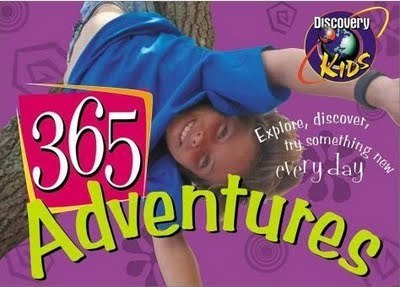
 Apologies for the disparate sizes of these images; some are old and I was too lazy to reformat.
Apologies for the disparate sizes of these images; some are old and I was too lazy to reformat.
Then over the next five years, I wrote about 35 more books…for the school and library market, also called the institutional market.
Institutional books are commonly published as a series and different titles in that series are commonly written by different people; each book in any given series must adhere to guidelines the publisher established specifically for it. Series I wrote for include We the People (American history), Endangered! (threatened animals), Atomic! (high interest topics from gladiators to vampires), and Countries of the World (countries of the world).
In between, I also continued to write trade books including What's the Difference?, How to Do a Belly Flop!, and Boys of Steel: The Creators of Superman. (Hey, at least one of those three titles does not end with a punctuation mark.)
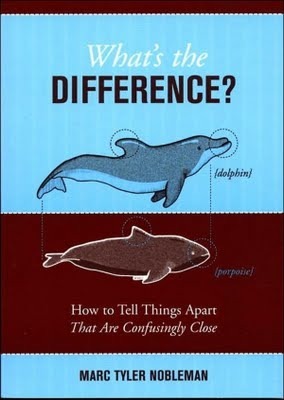
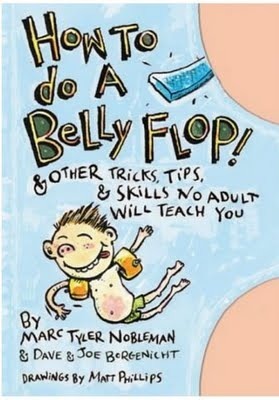
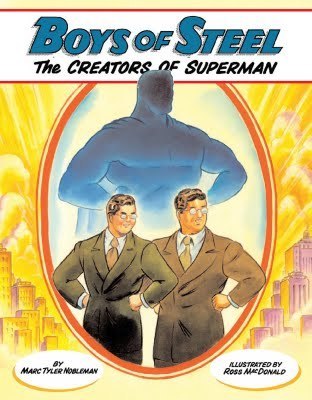 I would've preferred to focus only on trade books from the onset, but for most of us, it takes time and luck to get to that stage. In the meantime, I considered writing school and library books my day job (without the insurance or Secret Santa parties). Even when it's been a struggle, I always preferred sticking it out (after all, it was still writing) rather than going back to a salaried 9-5 office job.
I would've preferred to focus only on trade books from the onset, but for most of us, it takes time and luck to get to that stage. In the meantime, I considered writing school and library books my day job (without the insurance or Secret Santa parties). Even when it's been a struggle, I always preferred sticking it out (after all, it was still writing) rather than going back to a salaried 9-5 office job.
When writing for the institutional market, some authors use a pseudonym. One explanation I've read: they reserve their real name for when they write a "real" book.
Put another way, writing for an institutional series usually precludes creative experimentation. To cover the basics for a wide audience, these books take a straightforward approach. An author of an institutional book most likely didn't choose the subject from the ether; a publisher probably asked him if he would write on that particular topic. Sometimes editors say they want an institutional book to be written stylishly; while great in principle, it's frequently difficult in practice because such books have inflexible parameters (i.e. fixed word count and limited vocabulary, and despite that, a relatively vast amount of information to be conveyed).
Some authors withhold their name from a work-for-hire book because the book doesn't reflect the author's voice. I understand this. But I didn't do it. My name is on nearly all of my books. Just because a book can't be written with personal flair doesn't mean anybody can write it.
In part 2: why I used my real name on all but one of my books

My first published book (The Felix Activity Book) came out in 1996 (8/27/96, to be precise; anniversary greetings still being accepted). It was a trade book, meaning it was sold in bookstores. (Perhaps it's more accurate to say it was put in bookstores.)
 My second published book (and first "sequel"—Felix Explores Our World) came out in 1999, and it was also for the trade.
My second published book (and first "sequel"—Felix Explores Our World) came out in 1999, and it was also for the trade.  In 2000, I wrote two more books for the retail market, both for Dutton. (When one of them went out of print by 2005, I resold it to another publisher.)
In 2000, I wrote two more books for the retail market, both for Dutton. (When one of them went out of print by 2005, I resold it to another publisher.)
 Apologies for the disparate sizes of these images; some are old and I was too lazy to reformat.
Apologies for the disparate sizes of these images; some are old and I was too lazy to reformat.Then over the next five years, I wrote about 35 more books…for the school and library market, also called the institutional market.
Institutional books are commonly published as a series and different titles in that series are commonly written by different people; each book in any given series must adhere to guidelines the publisher established specifically for it. Series I wrote for include We the People (American history), Endangered! (threatened animals), Atomic! (high interest topics from gladiators to vampires), and Countries of the World (countries of the world).
In between, I also continued to write trade books including What's the Difference?, How to Do a Belly Flop!, and Boys of Steel: The Creators of Superman. (Hey, at least one of those three titles does not end with a punctuation mark.)


 I would've preferred to focus only on trade books from the onset, but for most of us, it takes time and luck to get to that stage. In the meantime, I considered writing school and library books my day job (without the insurance or Secret Santa parties). Even when it's been a struggle, I always preferred sticking it out (after all, it was still writing) rather than going back to a salaried 9-5 office job.
I would've preferred to focus only on trade books from the onset, but for most of us, it takes time and luck to get to that stage. In the meantime, I considered writing school and library books my day job (without the insurance or Secret Santa parties). Even when it's been a struggle, I always preferred sticking it out (after all, it was still writing) rather than going back to a salaried 9-5 office job.When writing for the institutional market, some authors use a pseudonym. One explanation I've read: they reserve their real name for when they write a "real" book.
Put another way, writing for an institutional series usually precludes creative experimentation. To cover the basics for a wide audience, these books take a straightforward approach. An author of an institutional book most likely didn't choose the subject from the ether; a publisher probably asked him if he would write on that particular topic. Sometimes editors say they want an institutional book to be written stylishly; while great in principle, it's frequently difficult in practice because such books have inflexible parameters (i.e. fixed word count and limited vocabulary, and despite that, a relatively vast amount of information to be conveyed).
Some authors withhold their name from a work-for-hire book because the book doesn't reflect the author's voice. I understand this. But I didn't do it. My name is on nearly all of my books. Just because a book can't be written with personal flair doesn't mean anybody can write it.
In part 2: why I used my real name on all but one of my books
Published on August 28, 2011 04:09



